Once a quiet residential area on Istanbul’s Asian side, Kadıköy—and more specifically its Yeldeğirmeni neighborhood—has evolved into one of the city’s most compelling outdoor galleries. For lovers of street art, this district is a rare kind of place: layered, expressive, and still changing by the week. While the murals here don’t adhere to a single style or message, what connects them all is a sense of being in dialogue with the street, the sky, and the shifting sociopolitical realities of the city itself.
A short history
The explosion of street art in Kadıköy can be traced to the Mural Istanbul Festival, which began in 2012. Sponsored by the local municipality, the initiative invited artists from Turkey and abroad to create large-scale works on the sides of buildings—some rising six or seven stories high. It was an act of municipal risk-taking: an official endorsement of what was still largely considered an illegal form of expression. But it paid off. The area blossomed into a magnet for artists, photographers, and travelers with a taste for the alternative.
Yeldeğirmeni in particular stood out. A historically working-class neighborhood with early 20th-century roots, it has long carried a reputation for bohemian flair. While not as historically multi-ethnic as other neighborhoods like Fener & Balat, it has become one of the most artistically vibrant quarters on the Asian side of Istanbul. In recent decades, young creatives moved in, drawn by affordable rents and a spirit of experimentation. Street art wasn’t just tolerated here—it became part of the fabric of the place.
Yeldeğirmeni’s street art vibrates against a backdrop of early Republican architecture, art nouveau apartments, and quiet courtyards. Artistic cafés, small galleries, and alternative spaces now coexist alongside mosques, neighborhood groceries, and classic Turkish barber shops—deepening its creative pulse.
Walking the open-air gallery
We didn’t book a tour for our visit, though we had eyed this one (sadly it wasn't within budget). Instead, we followed two user-generated Google maps:
Not every piece listed was still standing—some had been painted over or weathered into illegibility. But that was part of the experience. And in wandering off it, we discovered newer works not yet documented.
You don’t need a strict itinerary to enjoy the murals here. Start near the Yeldeğirmeni Cultural Center and let your curiosity take the lead.
“Pray for Rain” by Fintan Magee (Australia)
One of the most emotionally resonant murals in Kadıköy’s street art landscape, Pray for Rain by Australian artist Fintan Magee rises from the side of a building like a contemporary fresco. Painted in 2017, this large-scale work features a group of young figures, each holding or lifting buckets—some balanced on heads, others clutched to their chests, one offered to the sky. Rendered in Magee’s signature painterly realism, the piece captures both the ordinary and the mythic.
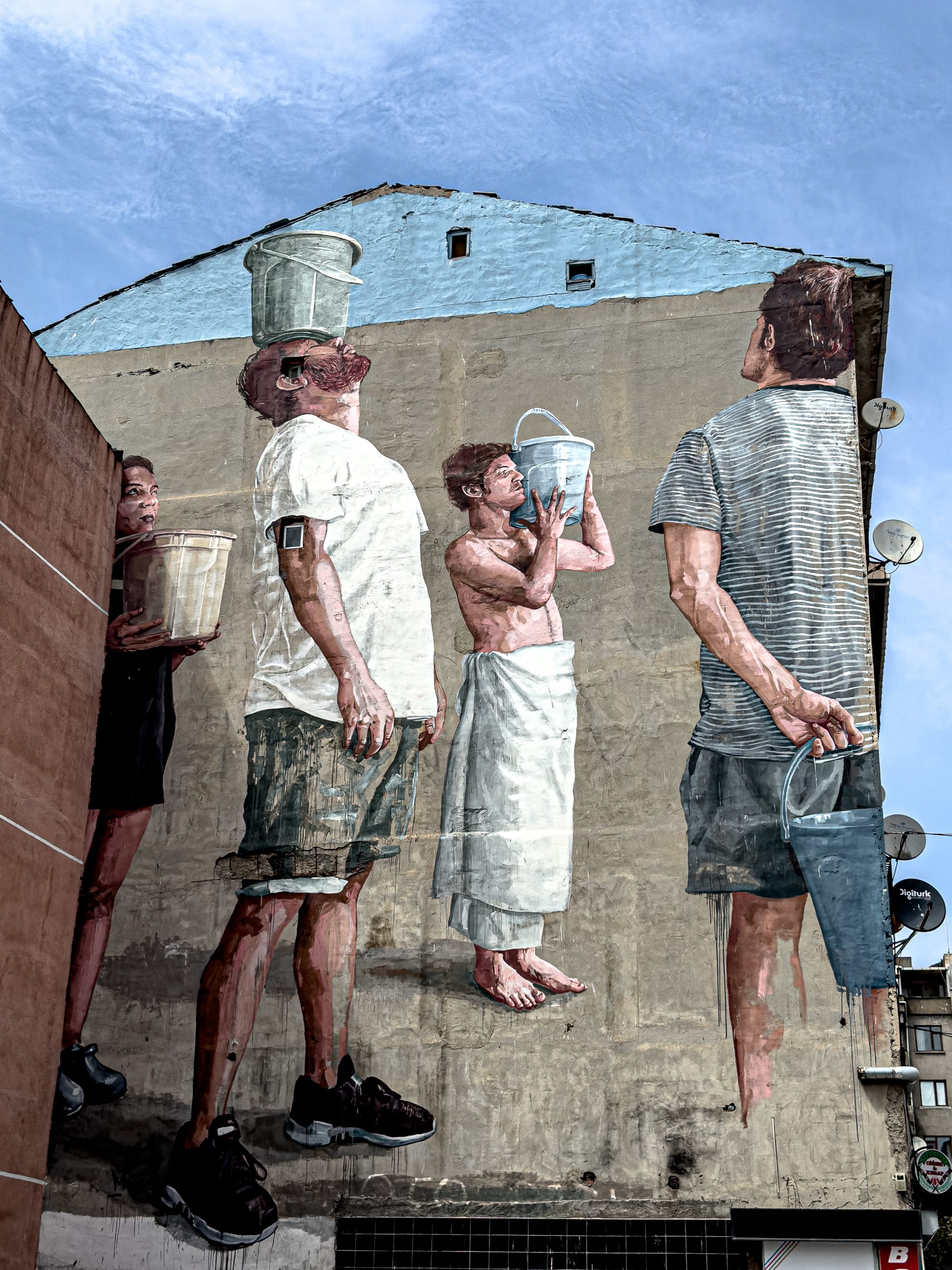
The mural reflects on Magee’s own experience growing up in Brisbane during the 2008 drought, when water restrictions transformed everyday routines. Locals were asked to collect their own shower water in buckets—an act of both adaptation and quiet desperation. At the time, Turkey and much of the Middle East were suffering a similar drought. In this context, Pray for Rain is a meditation on climate fragility, resource inequality, and the quiet rituals that emerge during crisis. It fits seamlessly into the layered psychogeography of Yeldeğirmeni, where memory, urgency, and collectivity shape public space.
“Resistencia” by INTI (Chile)
Painted during the politically charged summer of 2013, Resistencia by Chilean muralist INTI remains one of Kadıköy’s most iconic pieces. Towering over a quiet street, the mural features a hooded figure rendered in earth tones, cloaked in symbols, skulls, birds, and cosmological emblems. The word RESISTANCIA is faintly etched across the chest—a gesture of both defiance and endurance.
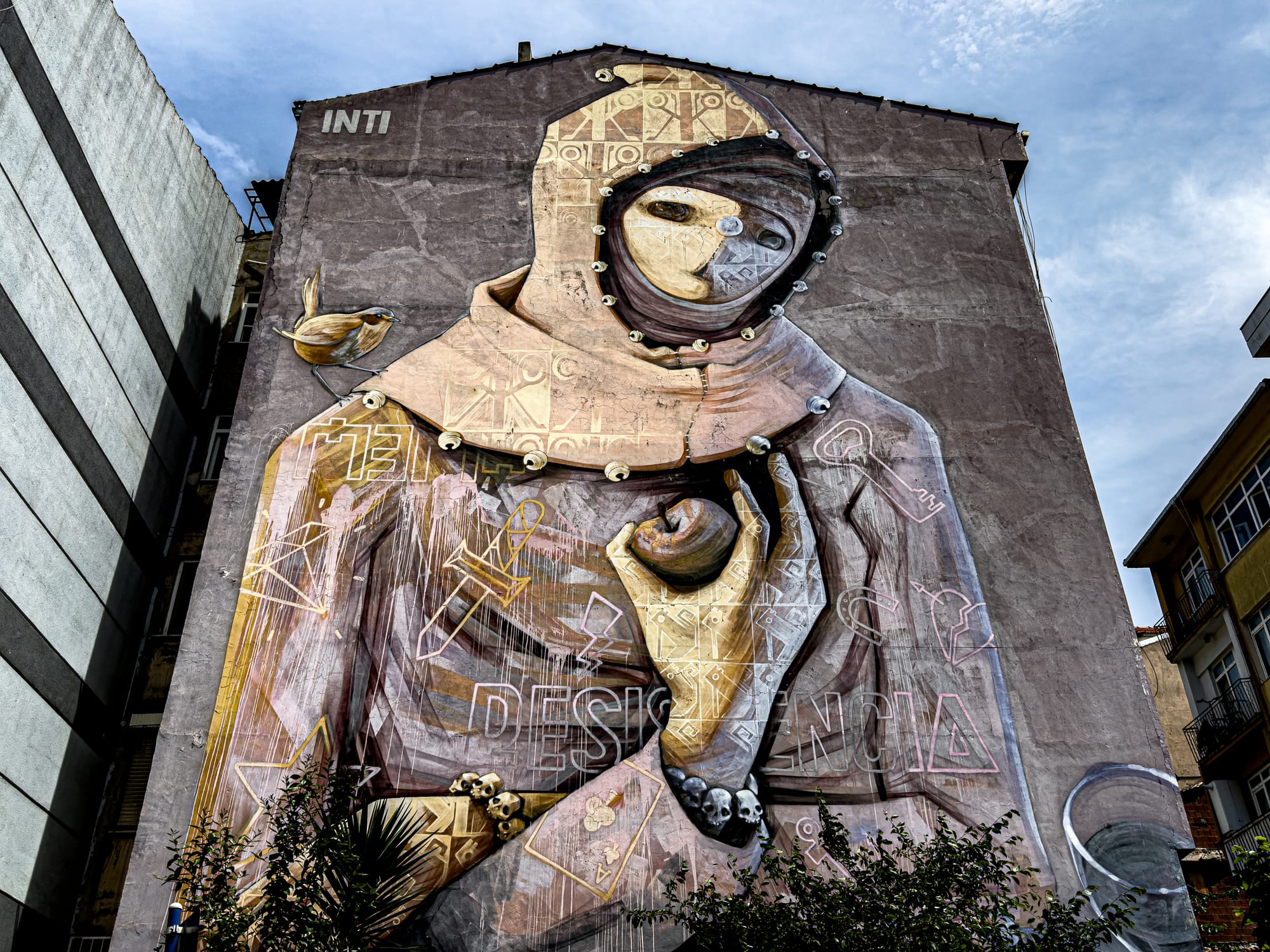
INTI is known for blending pre-Columbian imagery with modern political commentary, and this piece is no exception. His signature masked figure—pale-faced and celestial-eyed—recalls indigenous deities, revolutionaries, and cosmic archetypes all at once. The geometric symbols that cover the figure’s cloak echo Incan and Andean iconography, linking his Latin American heritage with global resistance movements.
Created in the wake of the Gezi Park protests, the mural resonates deeply with Istanbul’s own struggles for autonomy and voice. In a neighborhood like Yeldeğirmeni, already home to activist cafés, community centers, and open-air ateliers, Resistencia feels less like an outsider’s mark and more like a transnational kinship offering. Though faded by time, the mural’s spirit holds strong—watching over the city with a quiet, unwavering gaze.
“Sunbathing” by WD (Indonesia)
Painted in late 2019 by Indonesian street artist WD (Wild Drawing), Sunbathing stands tall and radiant in the Yeldeğirmeni neighborhood—both in scale and spirit. The mural features a young girl in a coral pink dress, surrounded by towering sunflowers that twist upward in lush, curling stems. One sunflower bends toward her face as she gazes upward, eyes closed, as though basking in the light or listening to something only she can hear.
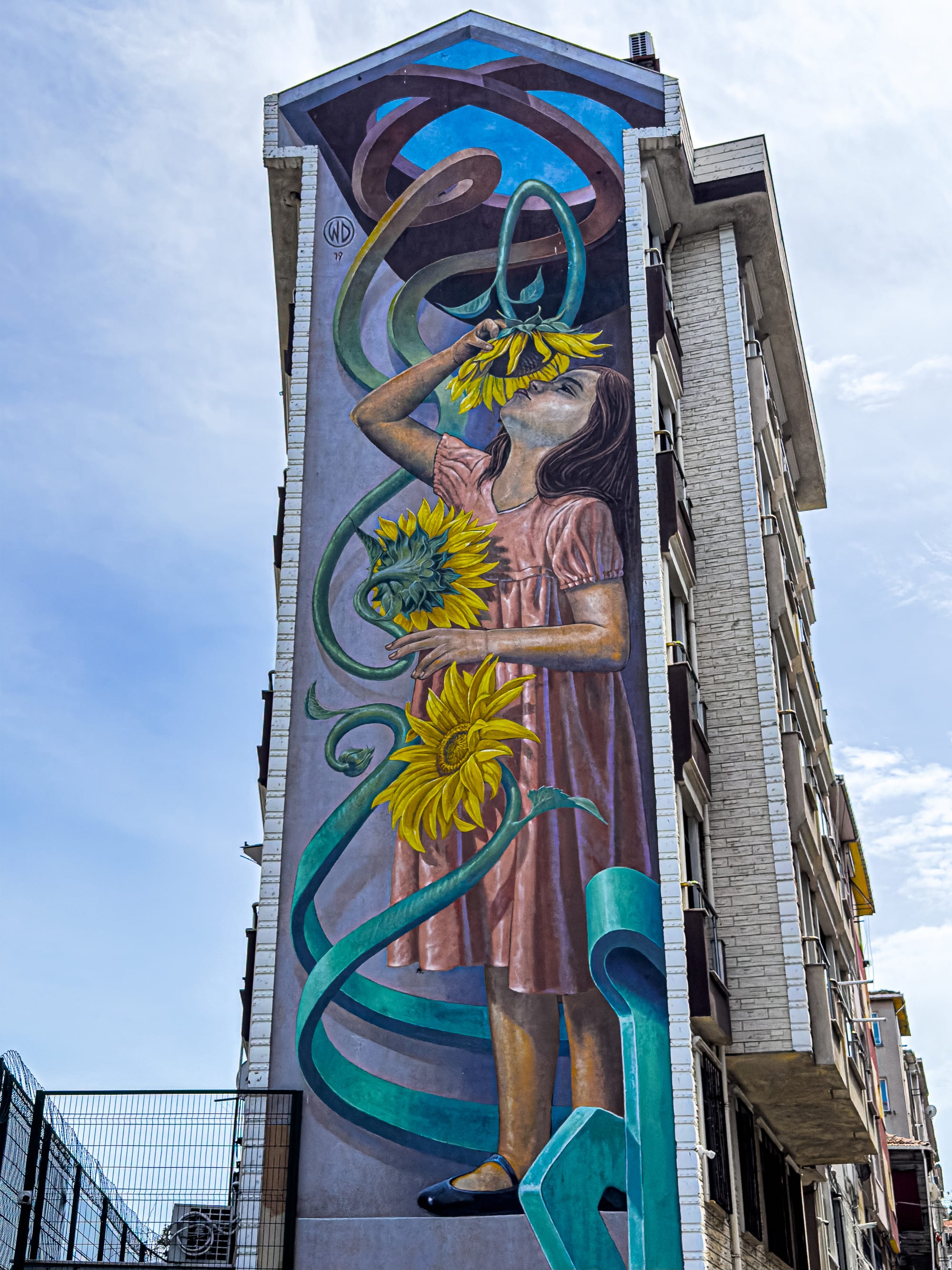
WD is known for his stunningly lifelike works, often playing with perspective and incorporating 3D effects to transform flat walls into theatrical illusions. Sunbathing is no exception. The way the ribbons of greenery fold around the girl, the subtle shadow play on her limbs and dress, and the almost tactile vibrancy of the flowers all give the mural a soft dimensionality that feels more dream than document.
Though not overtly political, the piece resonates with the ethos of gentleness and presence. In a rapidly changing city like Istanbul, where murals often comment on resistance, memory, and transformation, Sunbathing feels like a quiet breath. A reminder that beauty, rest, and curiosity are also revolutionary.
“Stay Hungry” by Sasha Korban (Ukraine)
Painted in 2019, Stay Hungry captures the poetic balance between sustenance and creativity. The mural’s protagonist—a young man clutching golden loaves and a paint bucket—stands in quiet resolve with a bird perched on his shoulder, suggesting both groundedness and gentle hope. The Ukrainian artist Sasha Korban crafted this piece for the Kadıköy Mural Festival, offering a message that reaches beyond hunger for food to a hunger for expression, growth, and connection.
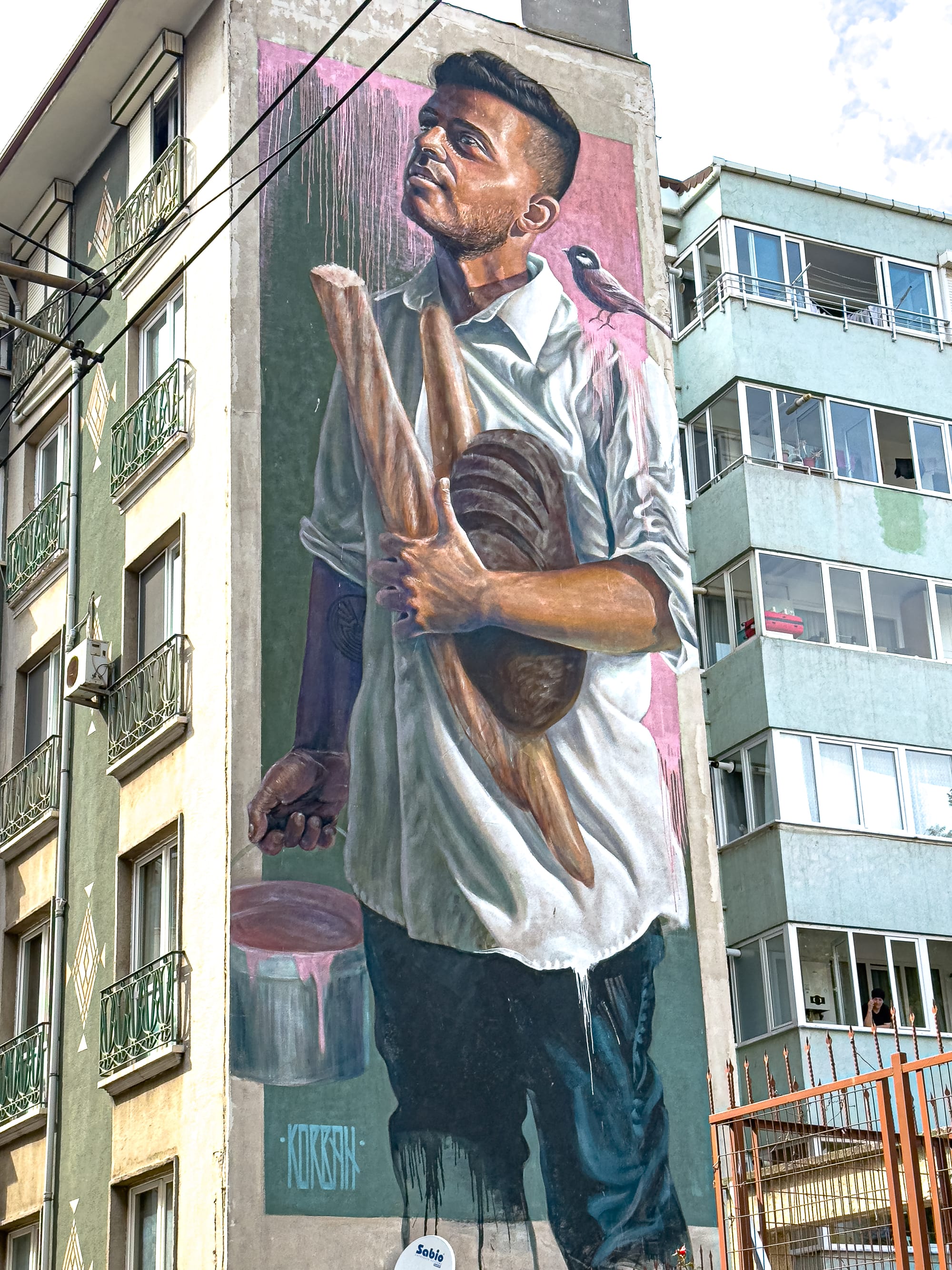
The mural aligns beautifully with Kadıköy’s ethos: a neighborhood where everyday life, art, and human aspiration are intertwined. The bread in this context becomes symbolic of survival and abundance, while the bird may hint at fleeting freedom or inspiration.
“Family” by Amose (France)
Family is a geometric visual symphony conceived by French artist Amose Vazimolo during the first Mural Istanbul Festival in 2012. The mural features two stylized human figures—one larger, one smaller—woven from clean, abstract shapes and vibrant color blocks. Its design evokes both tribal motifs and streamlined modernism, paying subtle homage to community and belonging in a city as multifaceted as Istanbul.
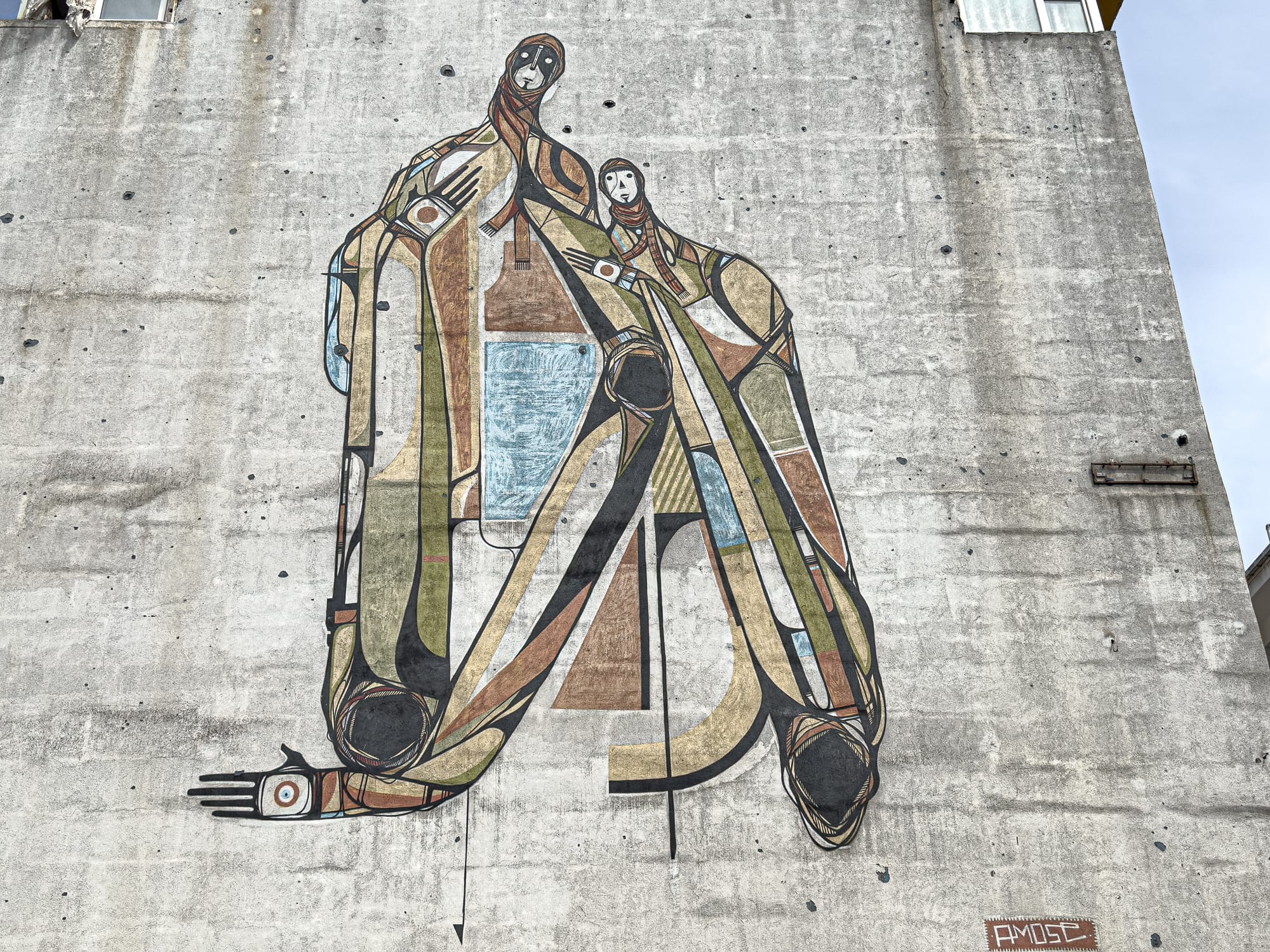
In a neighborhood with a rich history of multicultural coexistence and creative reinvention, Family stands as a gentle yet confident emblem of solidarity and human connection. Though some of the original vibrancy has softened over time, the work continues to radiate a composed warmth.
“Young Woman” by Lonac (Croatia)
Located on Rıhtım Caddesi just across from the car park entrance, this quiet yet commanding mural by Croatian artist Lonac shows a young woman seated with her phone in hand, legs crossed, gaze averted. Titled Young Woman, the piece stands out for its photographic realism, soft palette, and expressive detail—from the subtle lighting on her skin to the creases in her denim jeans.
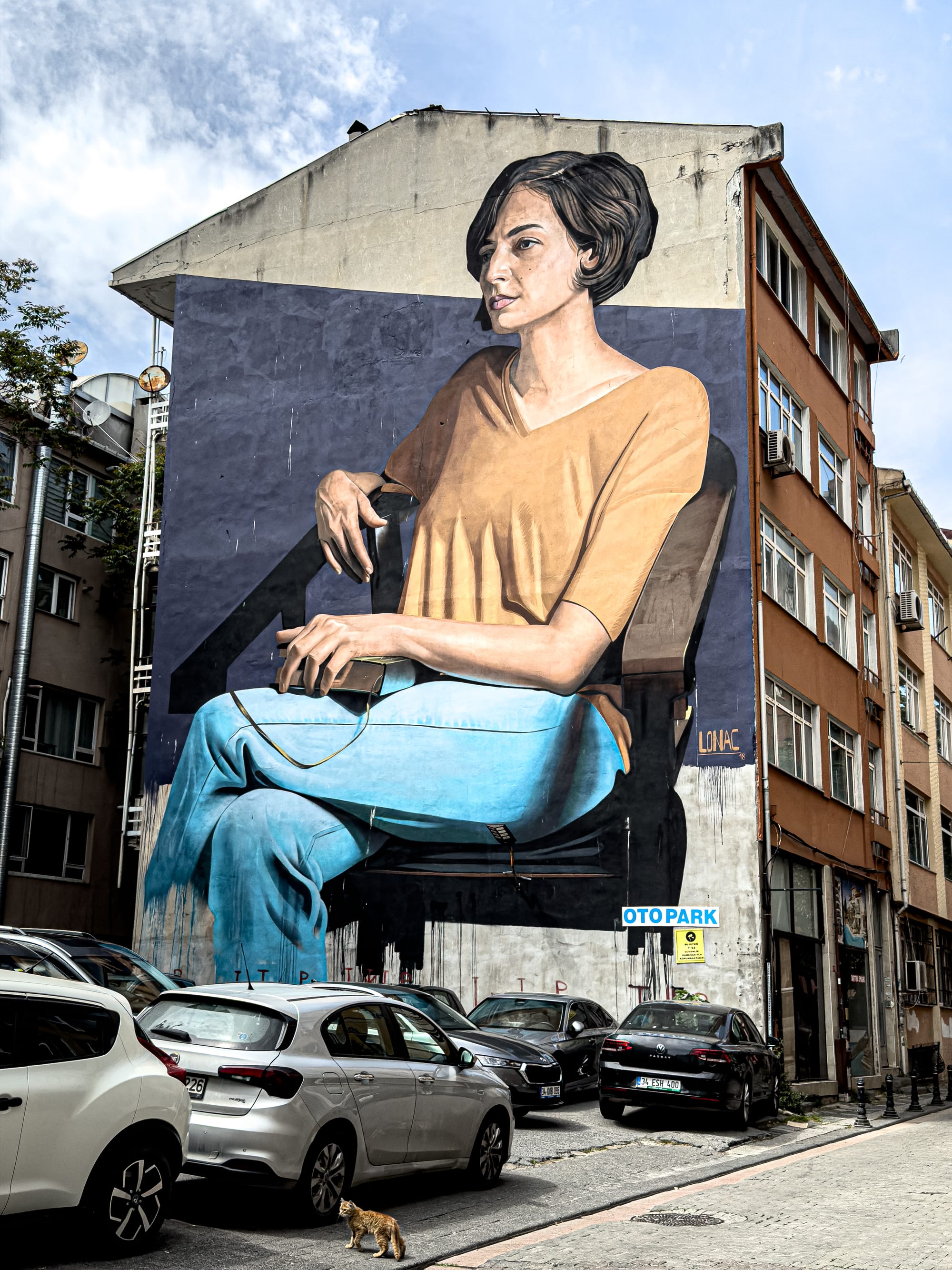
Lonac is known for his figurative murals that feel deeply human, often portraying moments of introspection, solitude, or gentle tension. Here, in the bustle of Kadıköy’s streets, this mural becomes a moment of pause. The figure’s gaze avoids the viewer’s, and her earphones suggest withdrawal from the external noise—a familiar posture in modern city life. There’s no heavy symbolism here—just a fleeting, familiar posture of quiet detachment rendered with disarming sincerity.
“Ark Istanbul” by Dome (Germany)
Painted by German street artist Dome, this expansive black-and-white mural portrays a surreal, densely packed boat carrying architectural structures, domestic objects, and elongated human figures. Located along a quieter backstreet in Yeldeğirmeni, the mural’s stark visual language immediately draws attention. The limited color palette and fine linework are signature elements of Dome’s style, which often leans into the surreal and the symbolic.
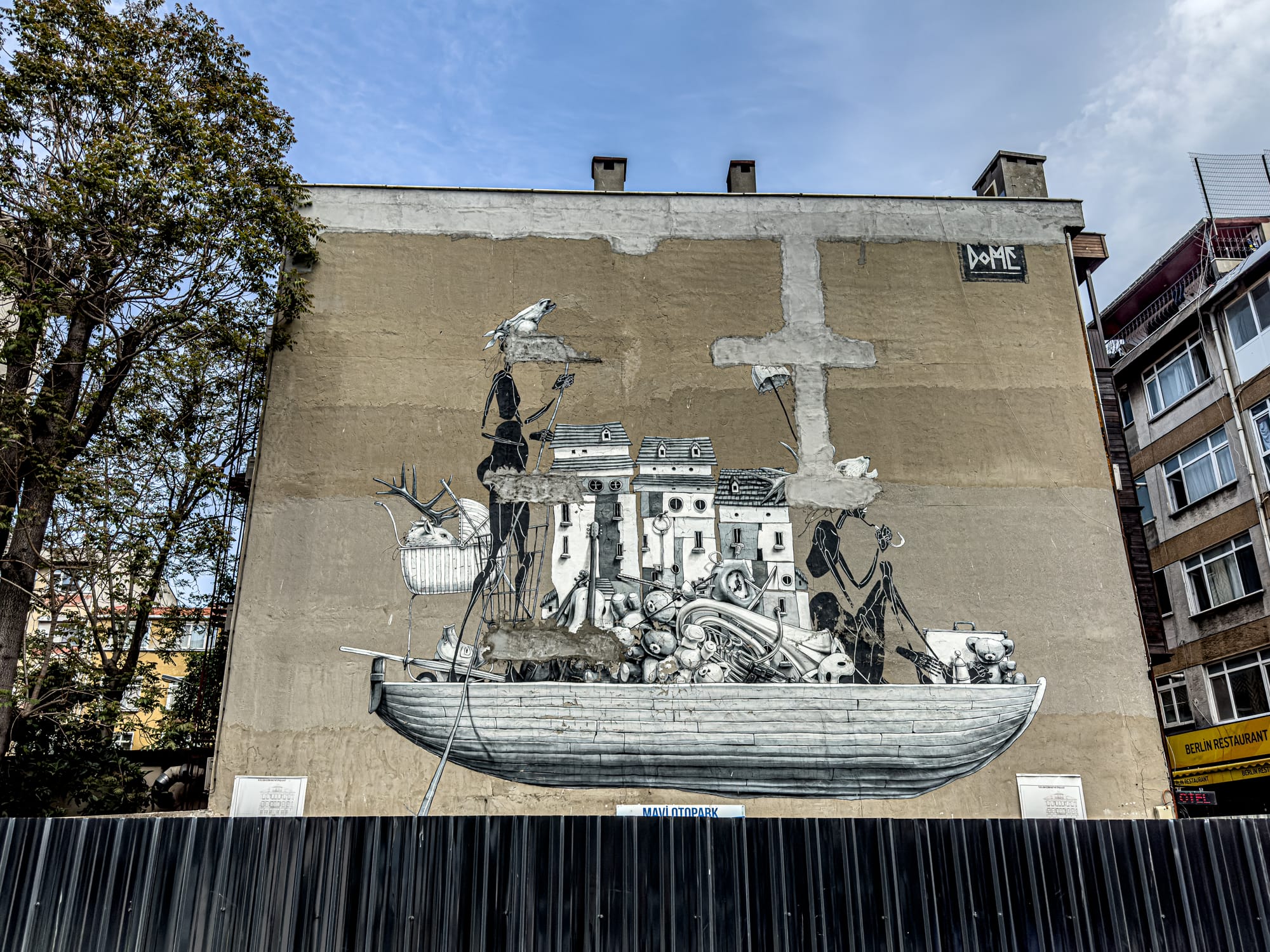
This particular work is often referred to by multiple titles—Ark Istanbul, Noah, or Refugees —and it speaks powerfully to themes of displacement, migration, and human precarity. The boat is overloaded—not just with bodies, but with entire homes and remnants of daily life, suggesting what people carry with them, physically and emotionally, when forced to flee. Several figures are seen navigating the boat with long poles, while birds rest on their heads or shoulders, adding a fragile, almost sacred stillness to the composition.
The wall’s patched background—featuring a large cross shape and faded textures—adds a layer of haunting ambiguity. Is this a cross of protection? A mark of faith? Or simply an accidental part of the wall’s history now folded into the artwork’s meaning? Dome leaves room for interpretation, inviting the viewer to linger and consider the complexities of refuge, survival, and hope.
The piece was painted as part of the original Mural Istanbul Festival in 2012, and today it stands as one of the most iconic and frequently photographed murals in Kadıköy.
"One Against One" by Jaz (Argentina)
Painted in 2013 for the Mural Istanbul Festival, One Against One by Argentine artist Jaz (Franco Fasoli) is among the most monumental and painterly works in Yeldeğirmeni. Towering above a shaded public square, this sepia-toned composition depicts two wrestlers locked in mythic combat—each rider straddling a horse, yet their forms blur into one another, raising questions about duality, identity, and inner conflict.
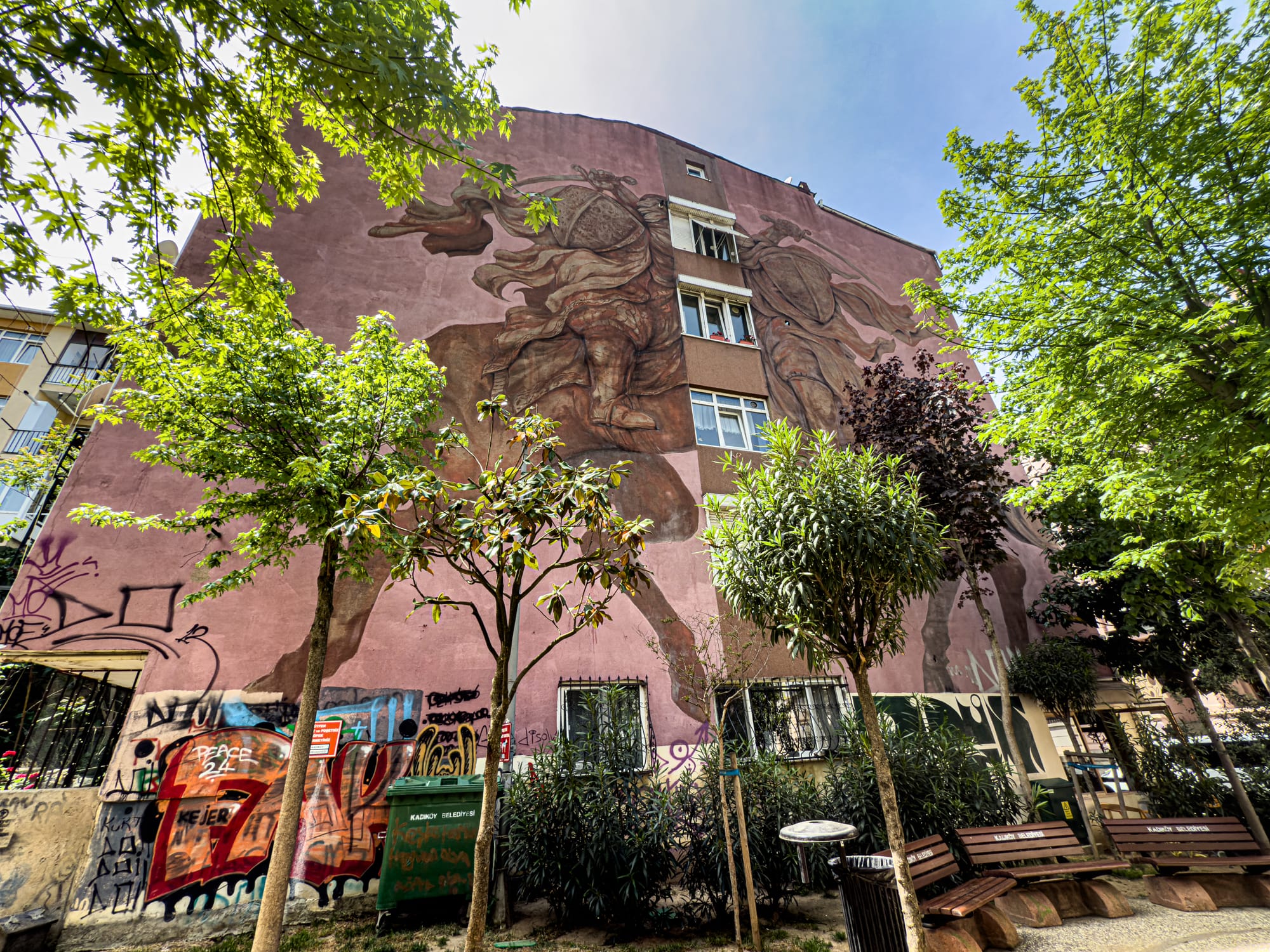
Fasoli, known for his background in scenography and visual arts, often uses animal-human hybrids and folkloric motifs to explore ideas of cultural tension and shared struggle. This piece—though eroded slightly by time—still conveys a kinetic, visceral power. Its earthy palette feels almost fresco-like, as if summoned from the walls rather than painted onto them.
Set just above a tree-filled seating area, One Against One becomes part of the urban pause: a massive, silent choreography hovering above daily life.
"Untitled" by Sepe & Chazme 718 (Poland)
Painted in 2014 as part of The Street Art Common Experience project, this work is a haunting, geometric collaboration between Polish street artists Sepe and Chazme (also known as Chazme 718). The mural depicts a surreal, blocky tower rising through the center of a fractured checkerboard world, surrounded by three factions of anonymous, cloaked figures. Each group marches inward from a different direction, hinting at ideological procession, blind faith, or the structures of power.
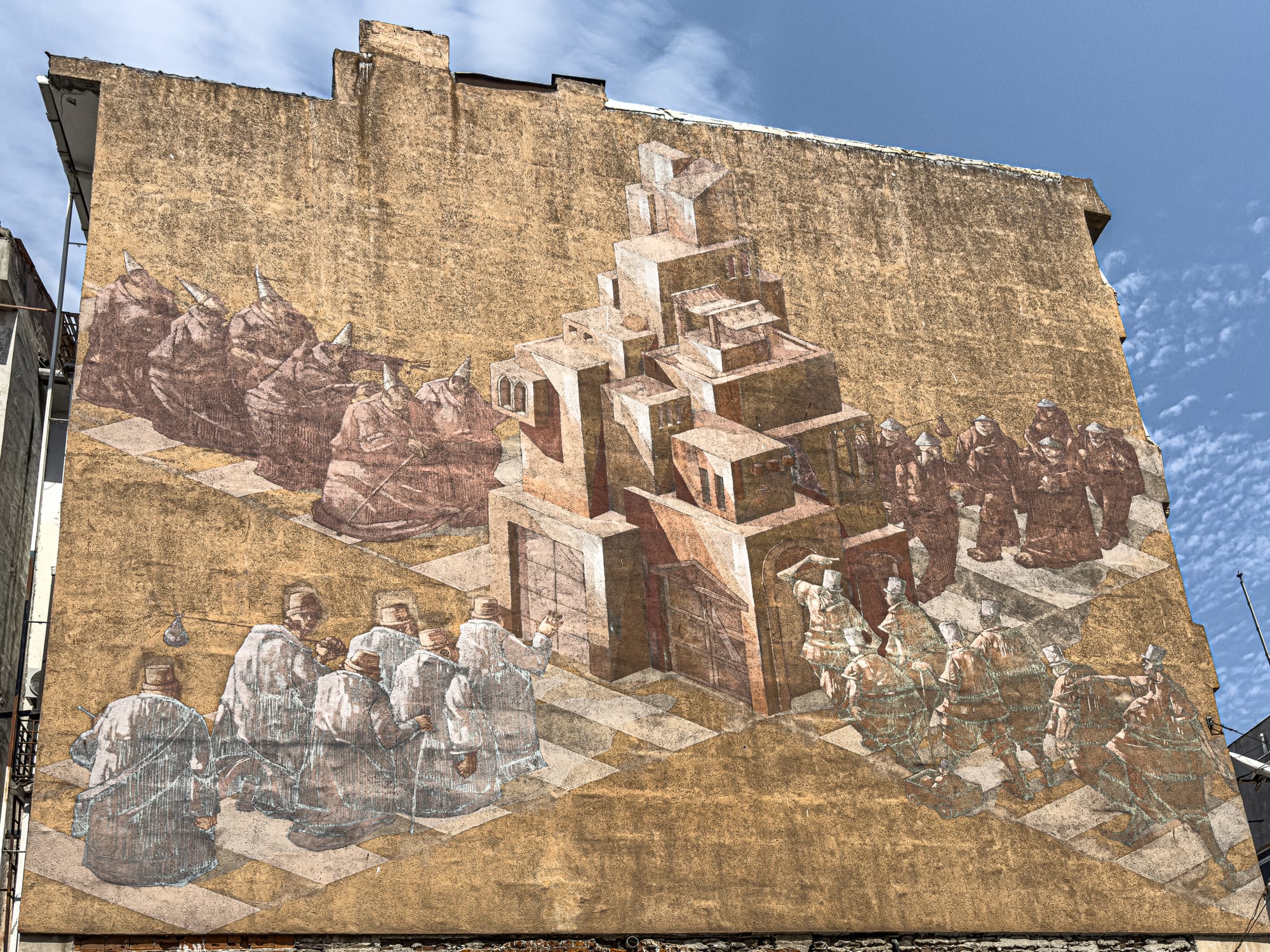
The architecture of the painting—stacked, skewed, almost crumbling—bears Chazme’s signature style: futuristic yet brutalist, orderly yet unstable. Sepe’s figures, often distorted and theatrical, evoke tension and ritual, a quiet kind of dissent or surrender. The muted tones and dry brushwork make the scene feel carved into the wall rather than painted on top of it.
The piece resonates with themes of conformity, bureaucracy, and historical cycles. It feels at once specific to Turkey’s social climate in 2014 and eerily timeless. A meditation on control, collapse, and collective motion.
This one really interested us, so we did a bit of our own browsing to find higher quality images closer to when it was painted.
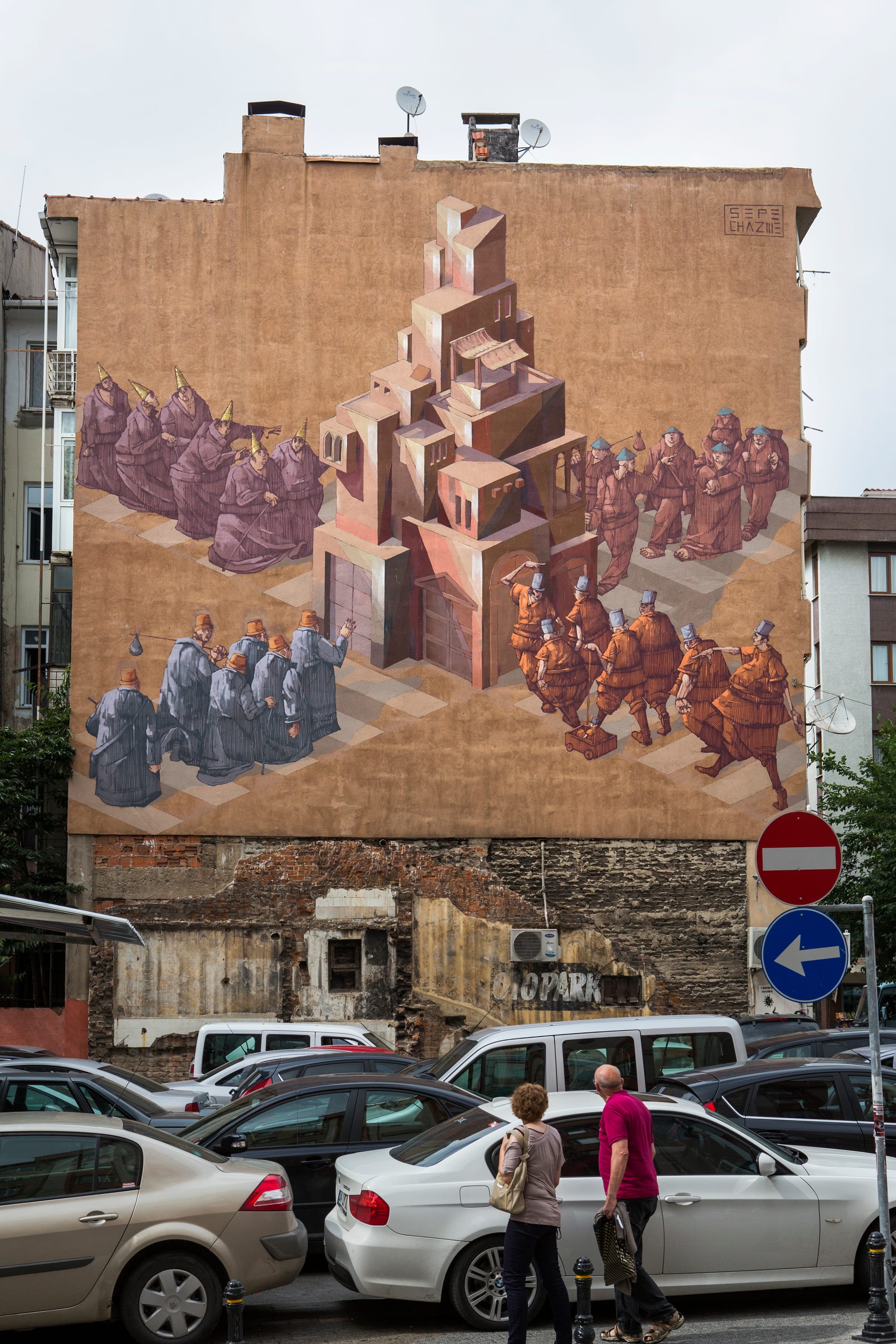
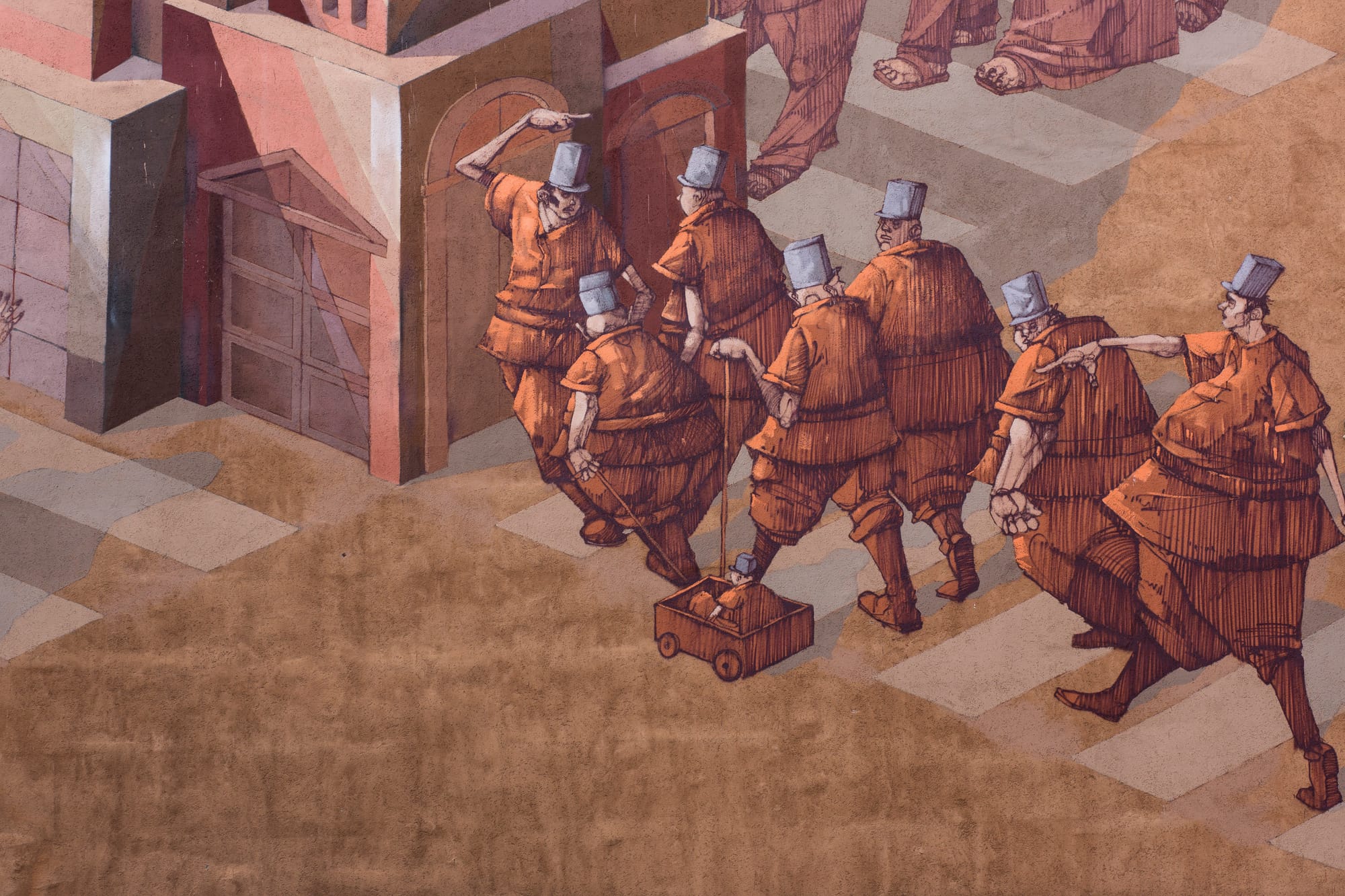
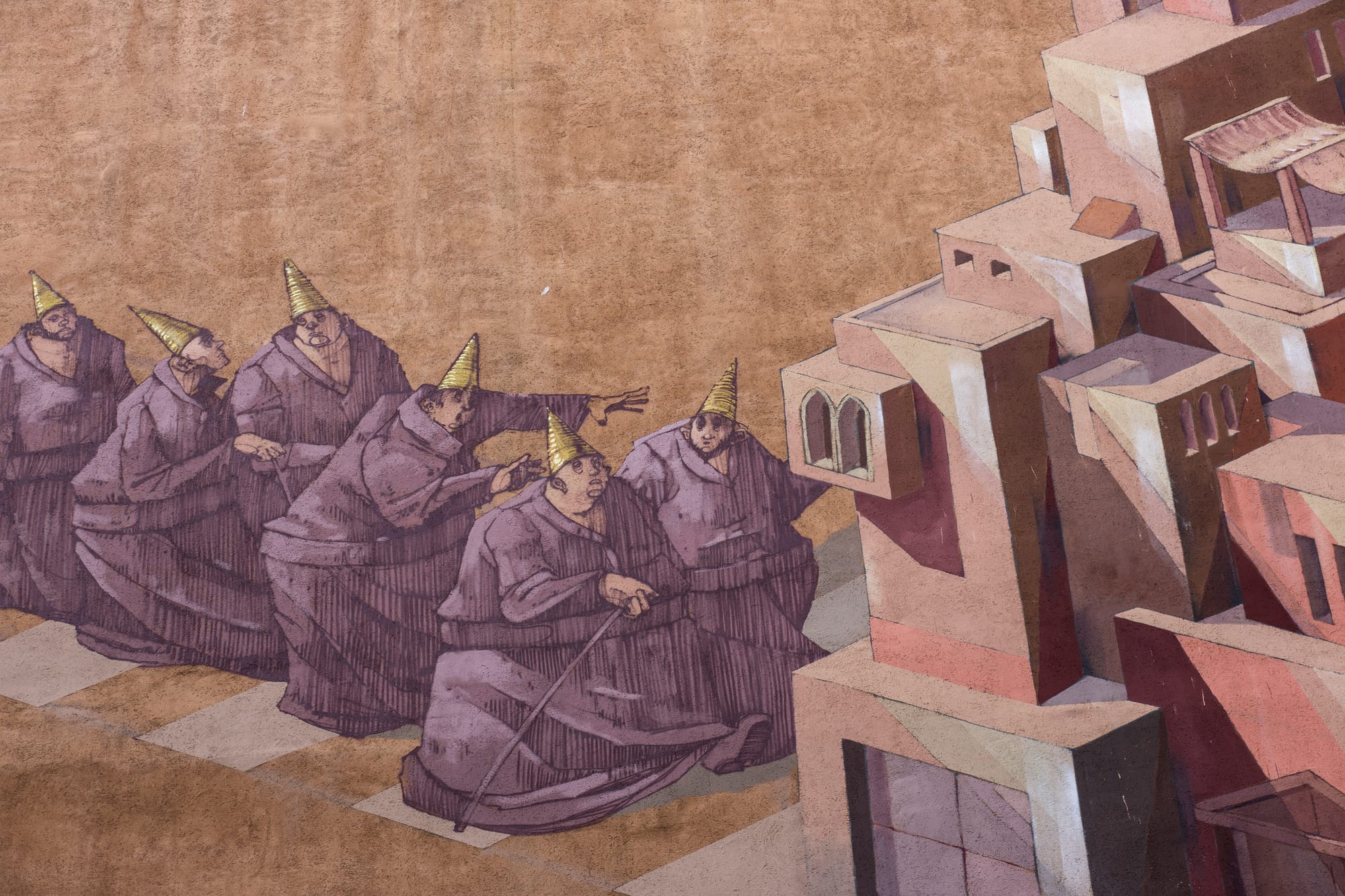
Captured closer to the date it was painted in 2014, these photos show the work’s original vibrancy and intricate detail
Photo credits to Fundacja Do Dzieła!
"Untitled" by M-City (Poland)
This monolithic black-and-white mural by Polish artist M-City towers ominously over a quiet backlot in Kadıköy. Created in 2014 as part of The Street Art Common Experience project, it shows a surreal, industrial landscape of cars being vacuumed skyward into a hovering, spacecraft-like machine.
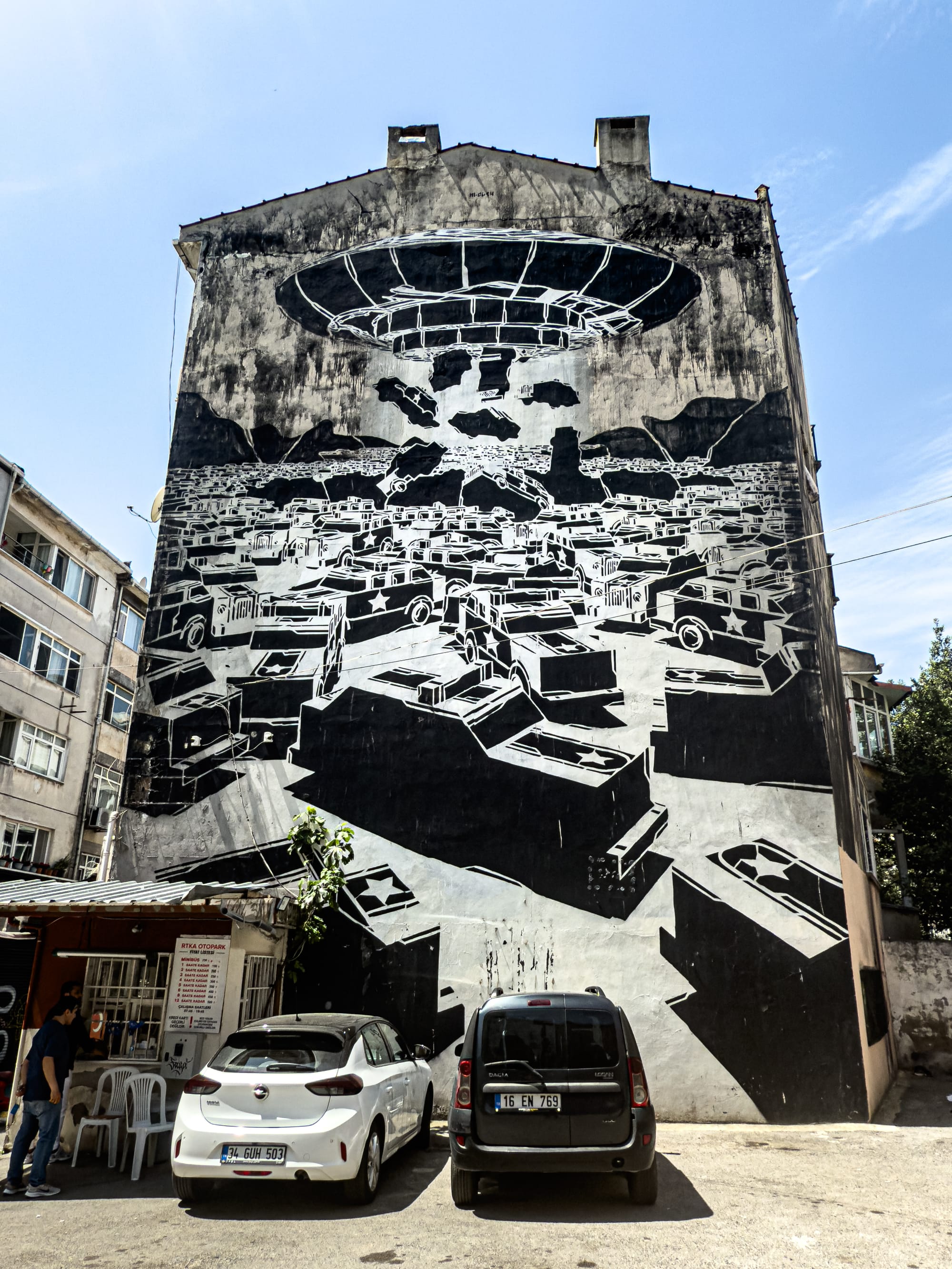
Look closer and you’ll notice that the vehicles resemble police or military vehicles. This seemingly small detail reframes the entire image: what first looks like a surreal cityscape transforms into a bold act of visual resistance. Is the artist envisioning a purge of state control? A reversal of power? A fantasy of demilitarization?
M-City’s work often draws from themes of control, surveillance, and industrial oppression—rendered through stenciled grids and brutalist geometry. Here, the absence of people is haunting. What remains are the systems: cars, machines, cities, infrastructure—autonomous, lifeless, and overwhelming.
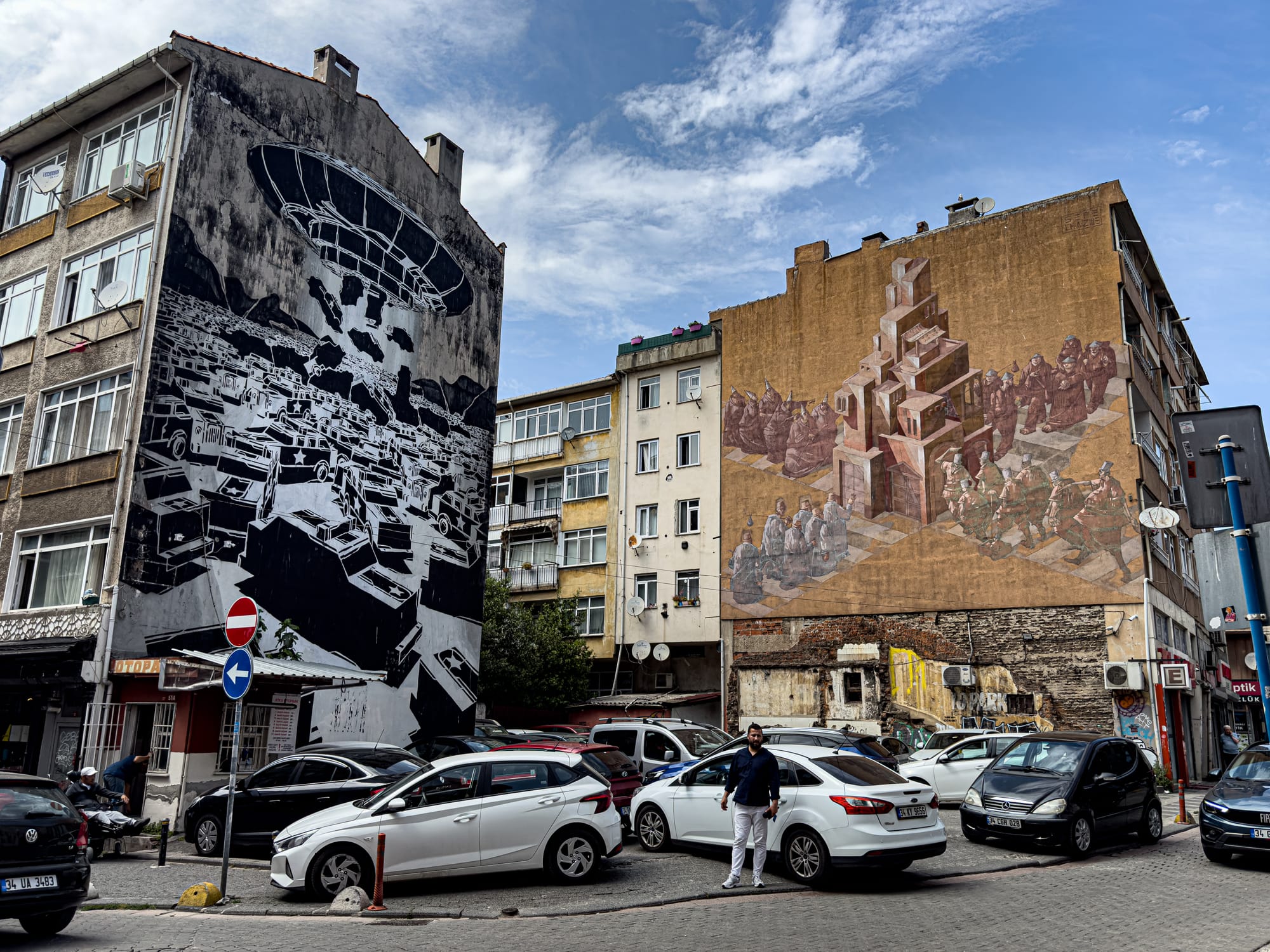
It’s one of the most visually aggressive murals in Kadıköy, and one of the most provocative. A vision of power being lifted, dismantled, or maybe just reorganized out of sight.
"Bambino" Pixel Pancho (Italy)
This unmistakable mural by Italian artist Pixel Pancho brings a surreal, steampunk vibrancy to the streets of Kadıköy. Titled Bambino—Italian for “kid”—it's a striking example of the artist’s signature fusion of humanity and machinery.
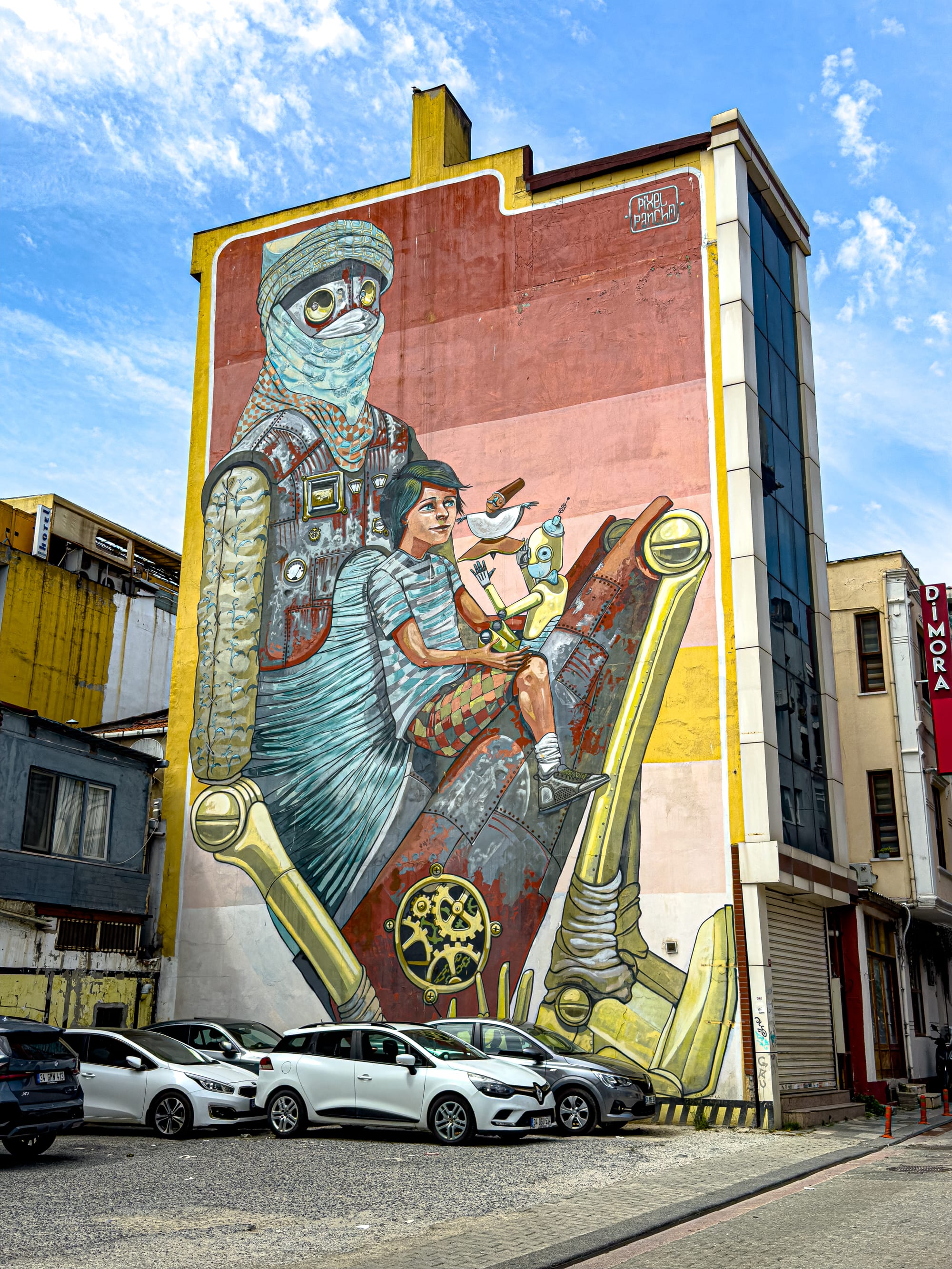
A robotic figure in a tattered blue shroud looms beside a woman perched atop a cyborg horse. The scene evokes the feeling of a mythic journey: a post-human knight and rider, crossing time and memory. A curious bird perches on the woman’s shoulder, echoing motifs often found in Pancho’s visual language—nature as witness, companion, or interruption.
Look closely and you’ll notice the elaborate gears, exposed bolts, and sinewy lines that lend the composition both weight and elegance. The color palette—dusty reds, bronze, pale turquoise, and mustard yellow—feels aged, as though the mural is both from the future and already rusting in place.
Though technically untitled, the piece reads like a mechanical folk tale, equal parts fable and warning. Pixel Pancho’s background in fine arts and sculpture comes through in the anatomical precision of his figures, while his street art roots show in the mural’s bold scale and raw edges.
It’s one of the more visually complex and narratively open works in Kadıköy—inviting viewers to ask: are we seeing liberation, or captivity?
Whether interpreted as a post-apocalyptic fable, a meditation on childhood in an age of machines, or a subtle commentary on power and dependence, Bambino remains one of the most thought-provoking and visually intricate works in Kadıköy’s open-air gallery.
"In Dreams" by Freddy Sam (South Africa)
Towering over a quiet side street in Yeldeğirmeni, this ghostly elephant by South African street artist Freddy Sam (aka Ricky Lee Gordon) evokes both dream and resistance. Titled In Dreams, the mural was painted in 2013 as part of the Mural-Ist Festival, coinciding with widespread protests that had gripped Turkey earlier that summer.
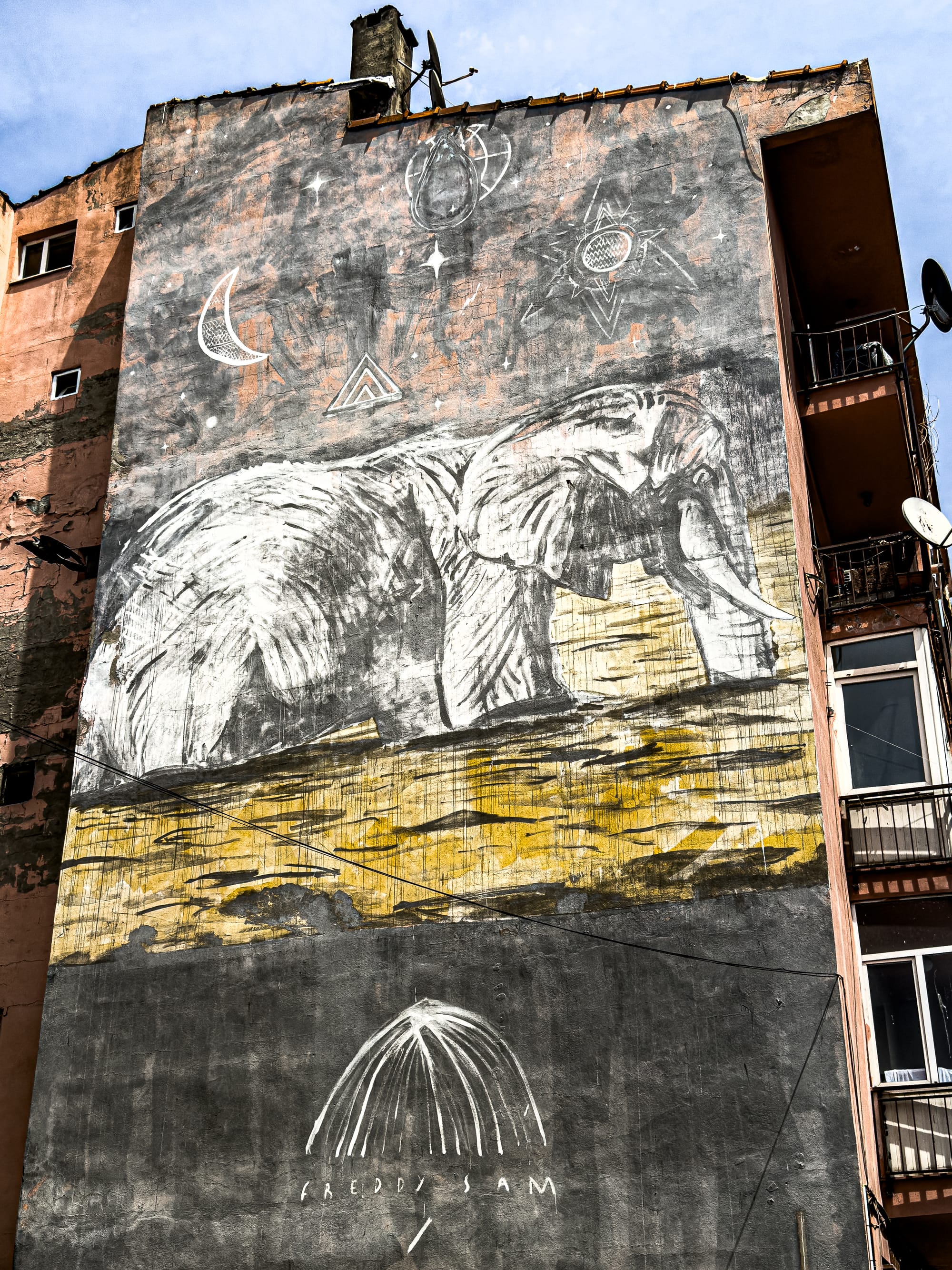
Rendered in chalky white lines against a textured, near-ashen background, the elephant appears suspended in motion—neither fully here nor entirely gone. Around it, symbols and glyphs—crescents, triangles, eyes—float like astral debris, reinforcing the dreamlike tone of the piece. Below, a gold-hued field unfurls across the wall, as if the animal were walking through memory or metaphor.
In African iconography, elephants are often associated with wisdom, strength, and resistance—qualities that resonate deeply with the mural’s temporal context. Though rooted in Cape Town’s visual and activist traditions, Freddy Sam’s work translates powerfully in Istanbul’s urban setting, where the act of painting itself becomes a gesture of presence and endurance.
"Balao" by Claudio Ethos (Brazil)
Hovering between whimsy and unease, this haunting mural by Claudio Ethos was painted in 2013 during the Mural-Ist festival in Kadıköy. Titled Balao—Portuguese for “balloon”—the piece features a surreal hot air balloon that seems more psychological than aerial.
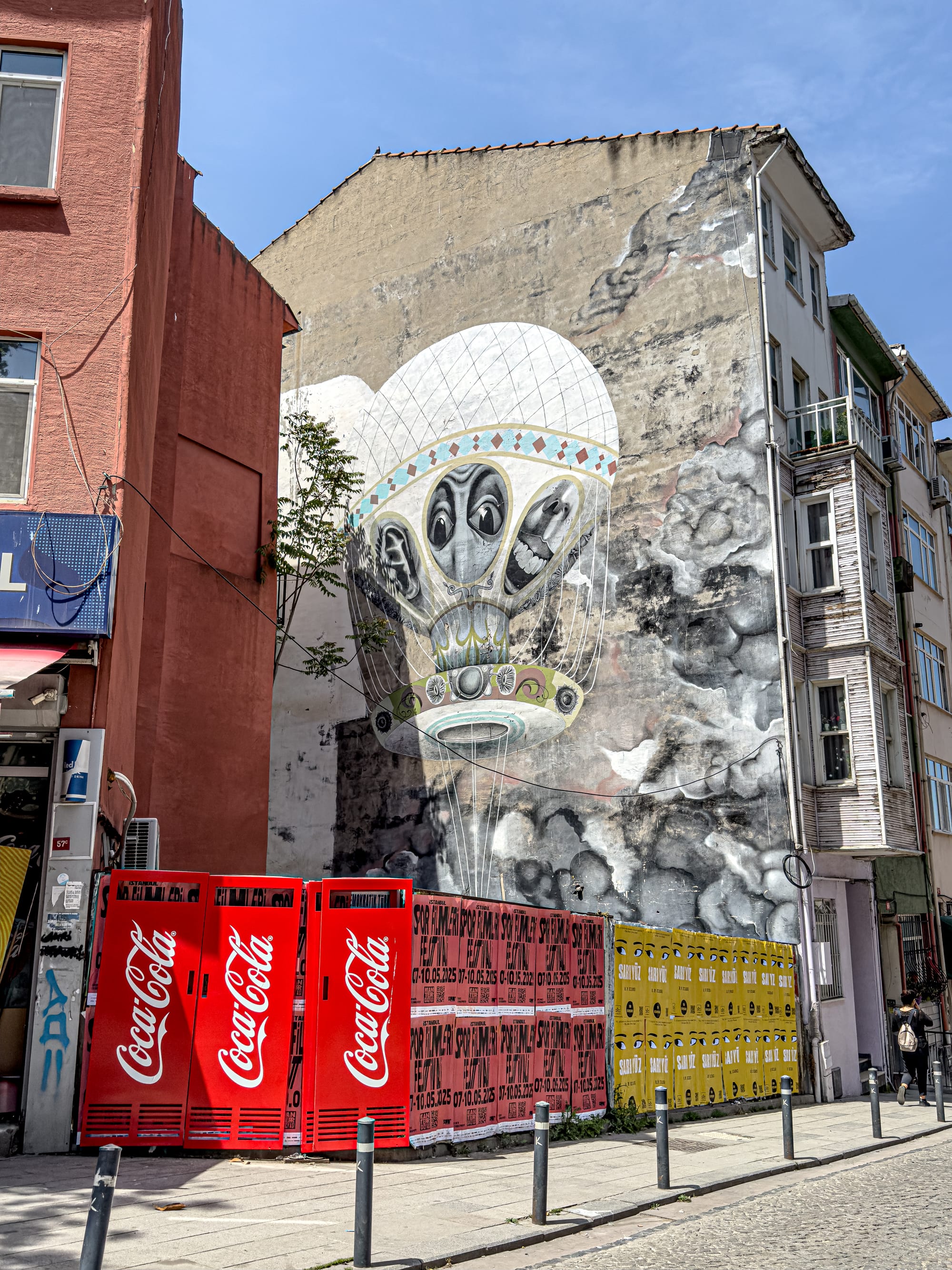
Instead of passengers or cargo, the balloon’s basket holds a cluster of contorted, expressive faces, their wide eyes and gaping mouths caught in varying states of wonder or dread. The balloon itself is tethered to a bed, which is just barely visible beneath the mural’s layers and weathering—a poignant symbol that suggests dreams, restlessness, and the subconscious as sites of departure.
Unlike more polished or idyllic representations of flight, Ethos’s vision feels fragmented, like a dream you can’t quite remember or a thought that refuses to settle. The use of muted greys, cloudy shadows, and that ambiguous pile of debris below gives the whole scene a floating tension—lightness resisting gravity, imagination weighed down by entropy.
Ethos’s distinct linework and fluidity are present here, though the mural has begun to fade slightly with time. Still, it carries an arresting presence, nestled between buildings and partially obscured by the city’s own clutter. Like much of his work, Balao invites introspection through distortion—it’s not just a balloon, but a metaphor rising from the wreckage, taking its strange passengers with it.
"Untitled" by Alex Maksiov (Ukraine)
One of the more playful and local-feeling works in Kadıköy’s mural constellation, this piece by Ukrainian artist Alex Maksiov was painted in 2018 and brings a seagull—Istanbul’s unofficial mascot—right to eye level. The exaggerated perspective makes the bird appear larger than life, almost architectural in scale, as it peers down with curious intensity from a background of abstract, geometric color fields.
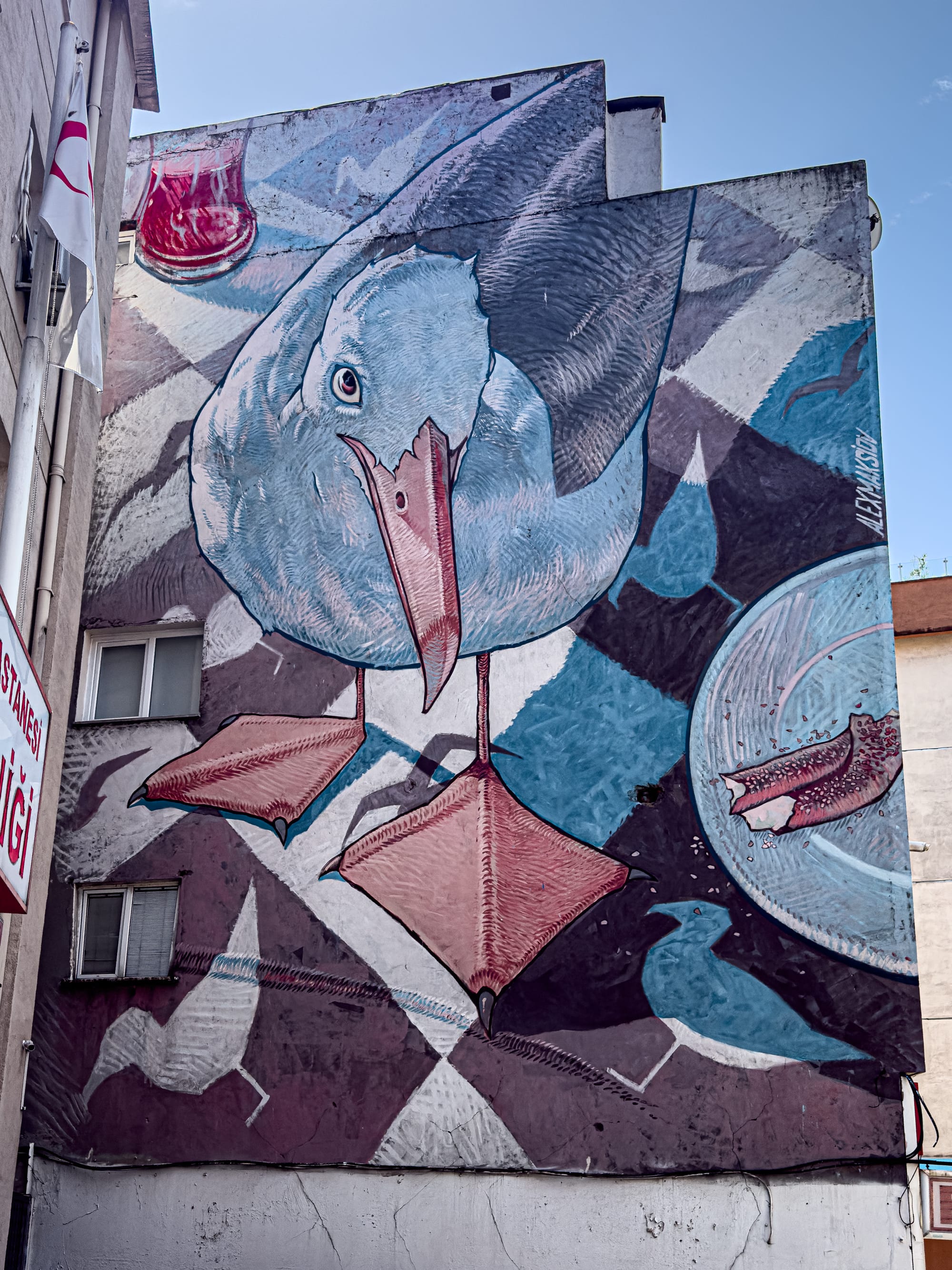
The elements orbiting the gull—a glass of Turkish tea, a half-eaten simit (sesame bread), and shadowy silhouettes of other birds—are unmistakable symbols of daily life in Istanbul. These aren’t just accessories; they root the mural in a shared urban language. Every local knows the chaos and charm of seagulls swooping in for a snack, especially along the waterfront where simit crumbs and tea glasses abound.
What makes this mural stand out is its hybrid tone: the stylized lines and almost woodcut-like feather texture give it a handcrafted, folk-tale feel, while the skewed proportions add a dash of comic surrealism. The color palette leans cool and dusty—muted reds, deep blues, seafoam greens—creating a quiet tension between serenity and absurdity.
Located in a cluster of three murals in the same square, Maksiov’s work balances humor, observation, and affection. It’s not trying to moralize or mystify. It simply captures a familiar, everyday creature with a sense of exaggerated reverence, honoring the banal as spectacular.
"Untitled" by Arlin Graff (Brazil)
Tearing across the pale turquoise wall of a corner building in Kadıköy, Brazilian artist Arlin Graff’s tiger erupts with kinetic energy. Created during the 2018 edition of the Mural Istanbul Festival, this piece doesn’t just depict a tiger—it roars through the architecture itself, swallowing windows, corners, and façades into its angular, abstract anatomy.
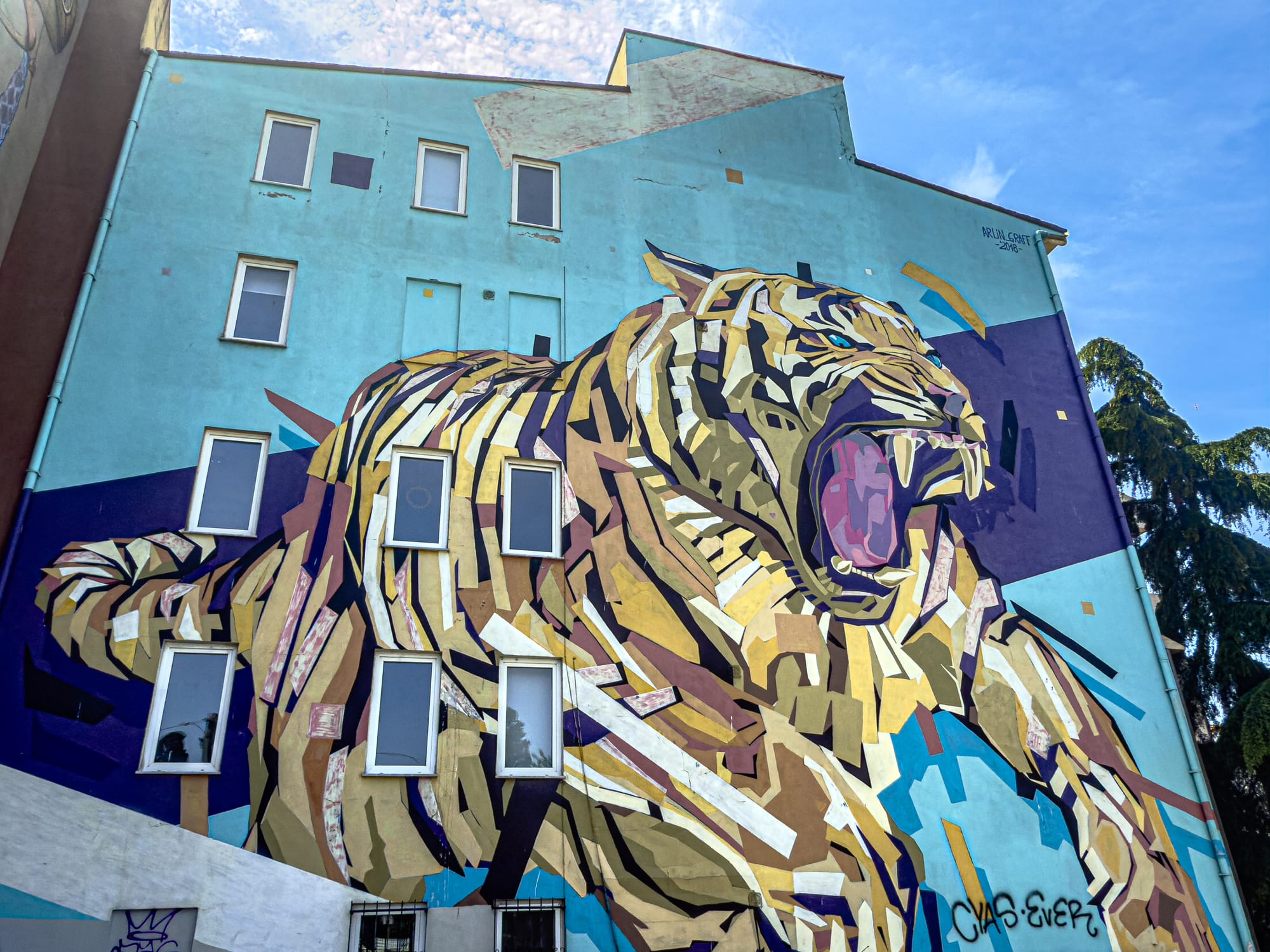
Graff is known for his geometric, deconstructed approach to form, and this tiger is a prime example. Rather than rendering a lifelike feline, Graff reduces its body to sharp shards of color—ochres, deep purples, bone whites, and unexpected flashes of teal. It’s a creature born of rhythm and tension, held together by the illusion of movement and the harmony of overlapping shapes.
What’s striking here is how well the mural embraces its context. The building’s many windows become part of the tiger’s musculature—embedded into its flank and chest—reminding the viewer that the city and its wildness are never separate. There’s something anarchic about this tiger too, its mouth wide open in a snarl, teeth bared not just at passersby but perhaps at the system itself.
The animal is both mythic and mechanical, fierce and pixelated. It’s not simply decorative. It’s a rupture. A reminder that even in cities where history weighs heavy, there is room for vivid, uncontainable new life.
"Untitled" by Cins (Turkey)
Spanning the full façade of a corner building in Kadıköy, Turkish artist Cins delivers a mural that’s equal parts chaotic, cartoonish, and cosmic. Split cleanly down the middle by the building’s rain gutter, the work plays with duality—night and day, death and rebirth, destruction and delirium—rendered in the artist’s unmistakable pop-surrealist style.
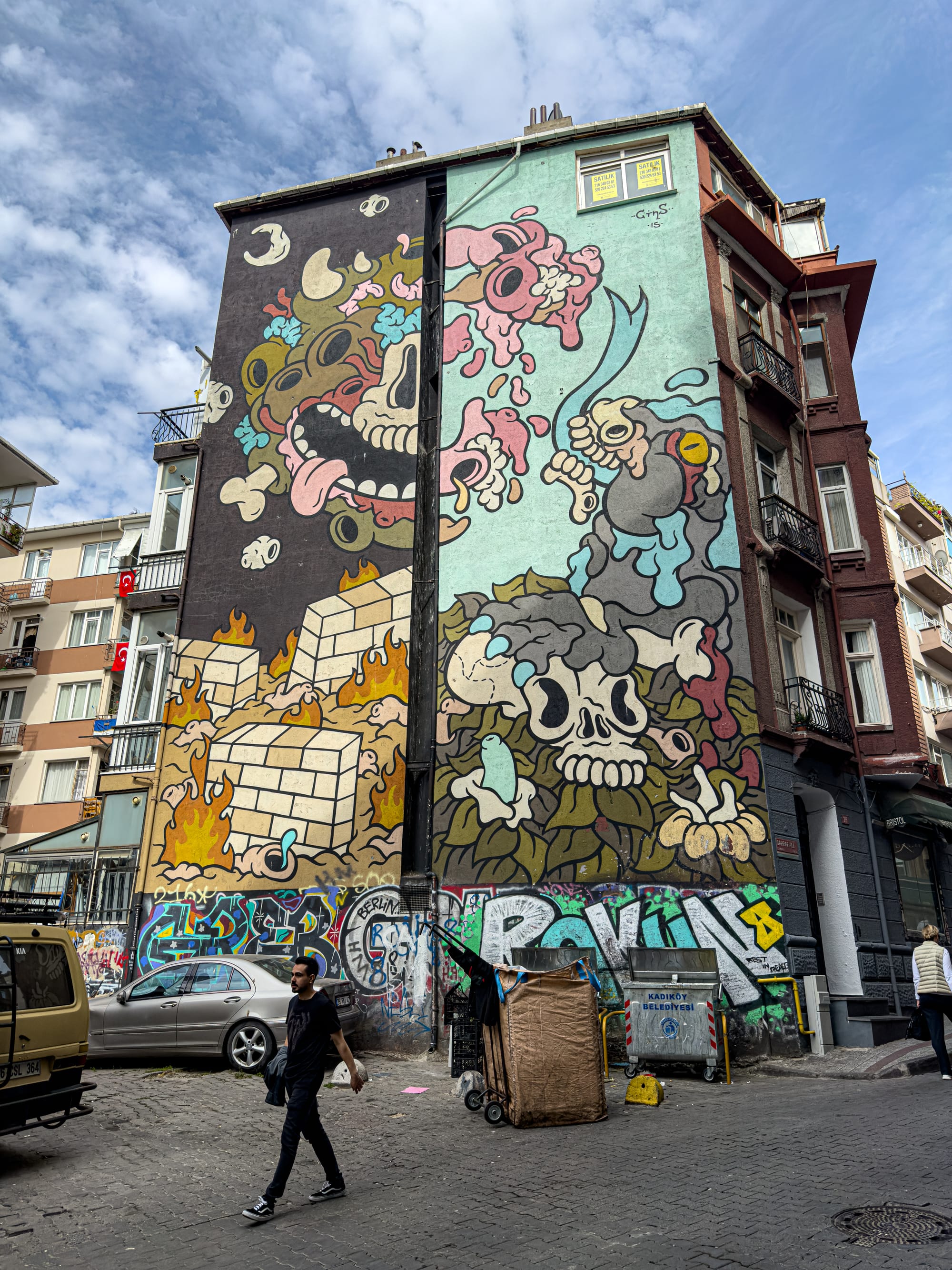
On the left, black dominates the background, setting the stage for a manic tangle of skulls, brick walls aflame, and disembodied eyes. The palette is intense: oranges, yellows, and sickly greens collide in scenes of absurd destruction. Over on the right, the atmosphere shifts. A lighter, mint-green sky opens above a chaotic parade of pirate swords, wide-eyed skulls, and bubbling pink matter. Is it a brain? Is it a flower? Is it both? With Cins, ambiguity is the point.
Known for his subversive comics and graphic language, Cins works in a visual vocabulary shaped by satire, absurdity, and local politics. There’s humor here, but it’s the kind that burns a little—cartoonish, yes, but deeply critical of authority, conflict, and the spectacle of collapse. The use of exaggerated linework, heavy outlines, and anthropomorphic forms ties the mural to the tradition of underground comics, yet it feels distinctly contemporary, grounded in Istanbul’s multilayered urban friction.
The division down the middle of the building could be read as a literal border—between opposing ideologies, between inner and outer worlds, or simply between two states of mind. One side engulfs, the other erupts. The city, caught between, wears them both.
"Untitled" by TWM Crew (Turkey)
Painted in 2016 by members of The Writer Material, this towering mural is one of the most visually commanding pieces in Kadıköy’s street art constellation. A striking figure, rendered in cool blues and bold outlines, stands grounded yet mythic—chest bare, gaze defiant, spear extended. Behind him, an eagle rises, head turned, wings abstracted into angular geometry. Around them: white lilies in bloom, curling leaves, and doubled profiles in dusky mauve.
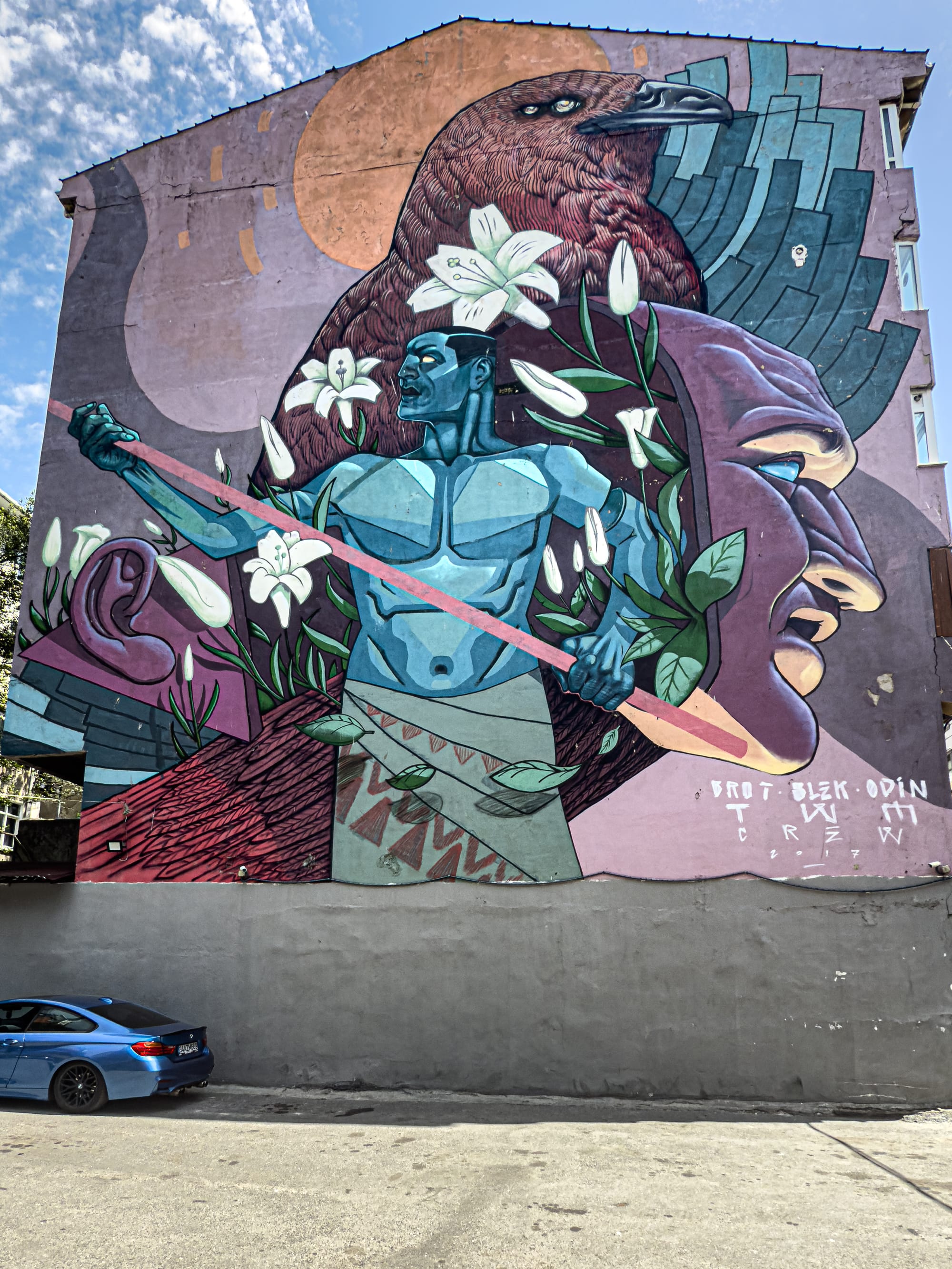
The mural reads like a fresco from an alternate timeline: part mythology, part protest, part rebirth. The blending of human and animal, flora and symbol, suggests a vision of hybridity and strength—a spiritual insurgency rooted in connection to land, ancestry, and the more-than-human world. The spear and eagle invoke protection, resistance, and watchfulness, while the flowers soften the intensity, holding space for grief, renewal, and care.
The TWM crew—Brot, Blek, and Odin among them—are known for large-scale collaborations that merge graffiti aesthetics with graphic narrative. Here, their hand is both illustrative and declarative, blending comic-book linework with muralist tradition. There’s a sense of drama, yes, but also of discipline. Every element is placed with intention.
Though officially untitled, the piece seems to embody a collective memory of struggle—past and ongoing. In the shadow of Istanbul’s rapid urbanization and deep political fault lines, this mural becomes more than just visual interruption; it’s a kind of public storytelling, speaking in mythic scale about survival, identity, and the will to grow in the ruins.
"Untitled" by Pilpeled (Israel)
This unapologetically bold piece by Pilpeled—one of Israel’s most well-known street artists—dominates the intersection with its graphic clarity and high-contrast drama. Against a saturated red backdrop, a black-and-white figure stares back at the viewer, hands held in front of her face, fingers forming an ocular triangle—the gesture of seeing and being seen. A crown sits atop her locs, inscribed with geometric motifs. Necklaces, tattoos, and eyes cover her skin like glyphs.
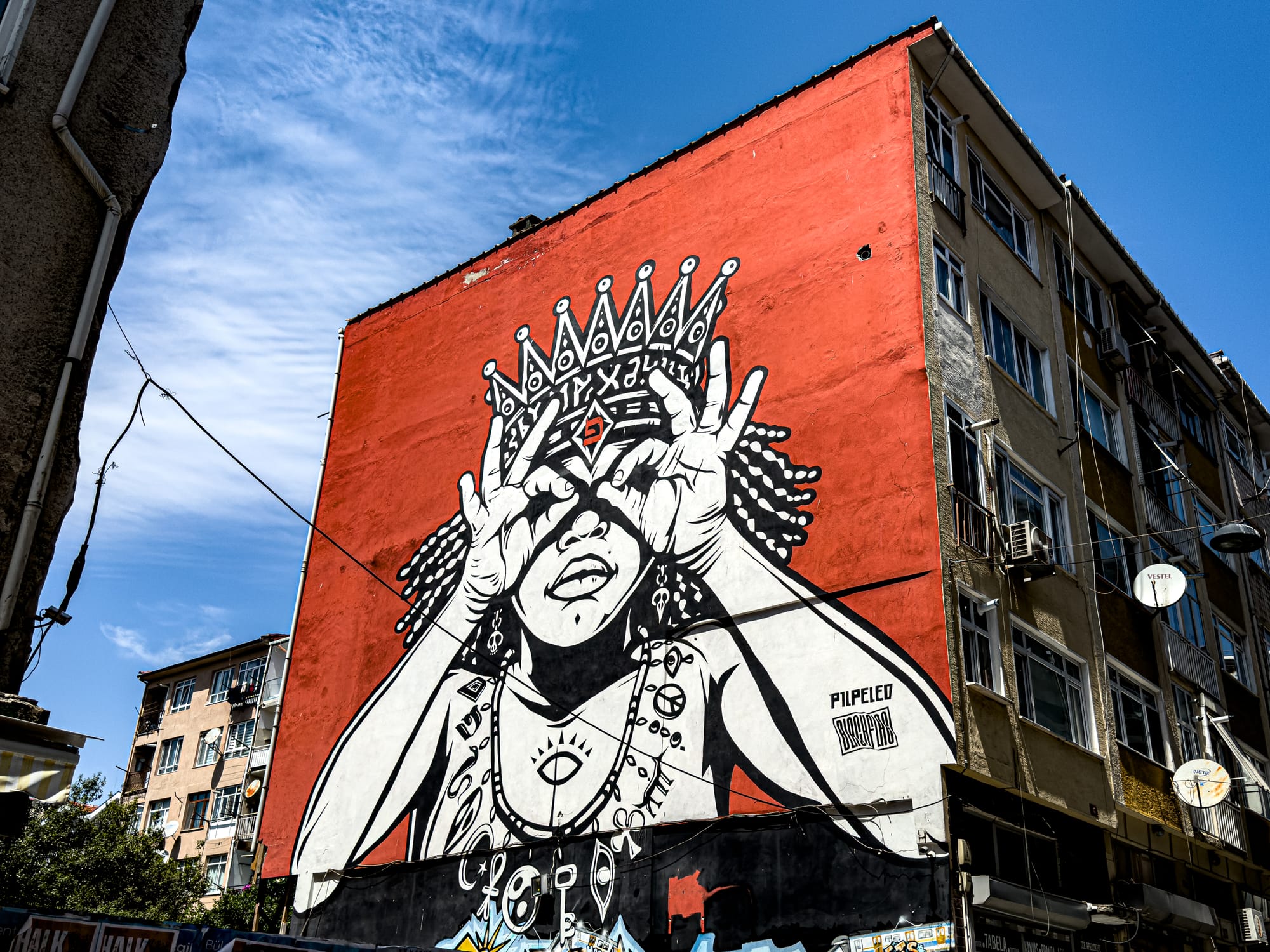
Pilpeled is known for mixing streetwear aesthetics, pop iconography, Middle Eastern mythology, and subversive portraiture. His work often draws from underground music and visual cultures, but it’s always deeply rooted in monochrome illustration—heavy lines, piercing gazes, symbols layered with meaning. In this mural, the artist balances power and surveillance, sovereignty and resistance. Who is watching whom?
The image feels both ancient and futuristic—tribal regalia meets graphic novel icon. The styling evokes diasporic femininity and urban royalty, but also carries tones of witchcraft, cosmology, and coded speech. The red background pulses with intensity, while the minimalist palette keeps the focus tight and symbolic.
There’s no formal title or known backstory for this work, but the message is visceral and immediate. In a neighborhood like Yeldeğirmeni—where visual culture is often intertwined with social commentary—this mural doesn’t just decorate the street, it asserts presence. It’s a mural that watches back.
"Sufi of Kadıköy" by Dabtar (Germany)
Standing like a psychedelic totem pole on the corner of a residential building, “Sufi of Kadıköy” by Dabtar, a German street artist affiliated with the Captain Borderline collective, is one of the most whimsical and surreal entries in the Kadıköy mural scene.
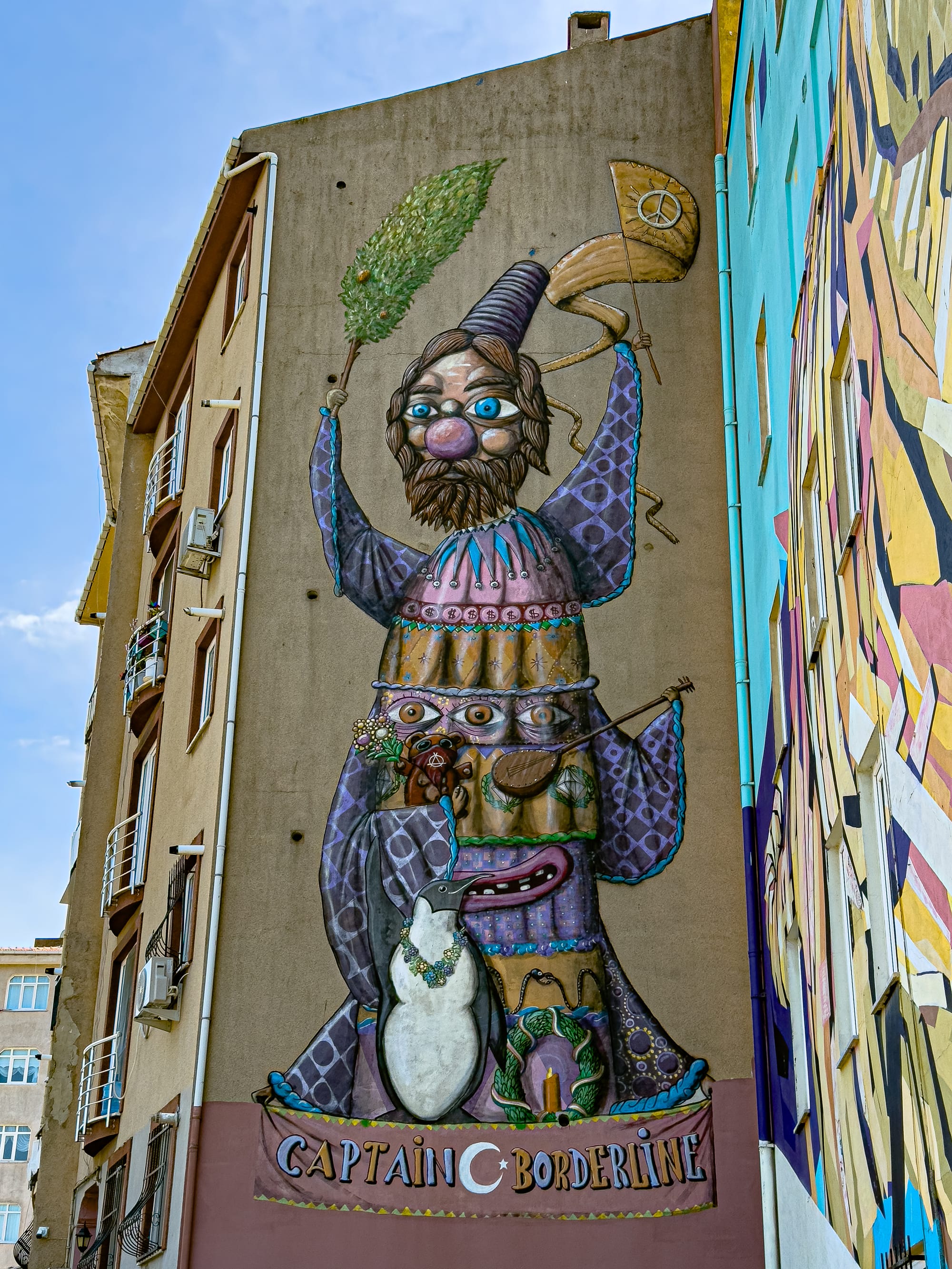
Painted in Dabtar’s unmistakable style—equal parts political satire, cosmic mythology, and absurdist cartoon—the mural features a stacked assemblage of characters, from a robed, cross-eyed sufi-like figure with a pine branch and a peace flag, to a penguin adorned with a gemstone necklace, all perched atop bizarrely expressive creatures. Each figure has its own textures, colors, and eccentric accessories, stitched together with wild-eyed intensity and over-the-top costume design.
The banner below the mural reads “Captain Borderline,” the name of Dabtar’s German street art crew known for their vibrant and anarchic murals across Europe. Their works often tackle themes of ecological collapse, authoritarianism, and spiritual confusion—with a healthy dose of dada-esque humor.
Here, the “Sufi” character seems to parody both mystical reverence and militarized nationalism, waving a pine branch like an olive branch and hoisting a flag emblazoned with the peace sign. The swirling eyes, psychedelic color gradients, and tiered layering of beings suggest both unity and chaos, a kind of spiritual ecosystem stacked on top of itself.
Fittingly located in Yeldeğirmeni, one of Istanbul’s most creatively charged neighborhoods, the piece exudes the layered cultural friction of the area—where sufi mysticism, cartoon rebellion, and European counterculture are all invited to occupy the same vertical space.
It’s weird, deeply charming, and exactly the kind of mural that keeps Kadıköy so visually and conceptually alive.
Unknown murals
We also saw some other murals we could not find any information on.
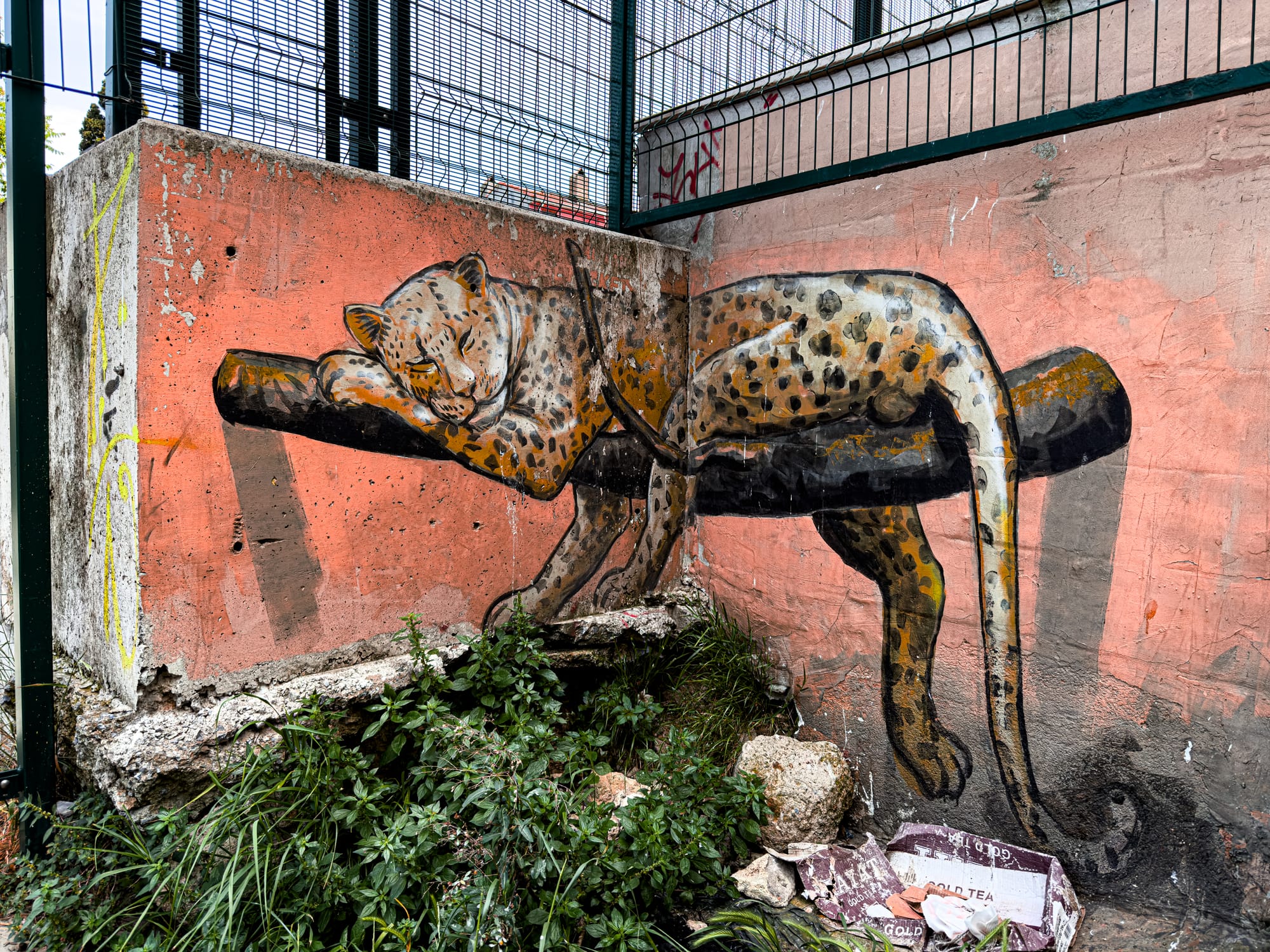
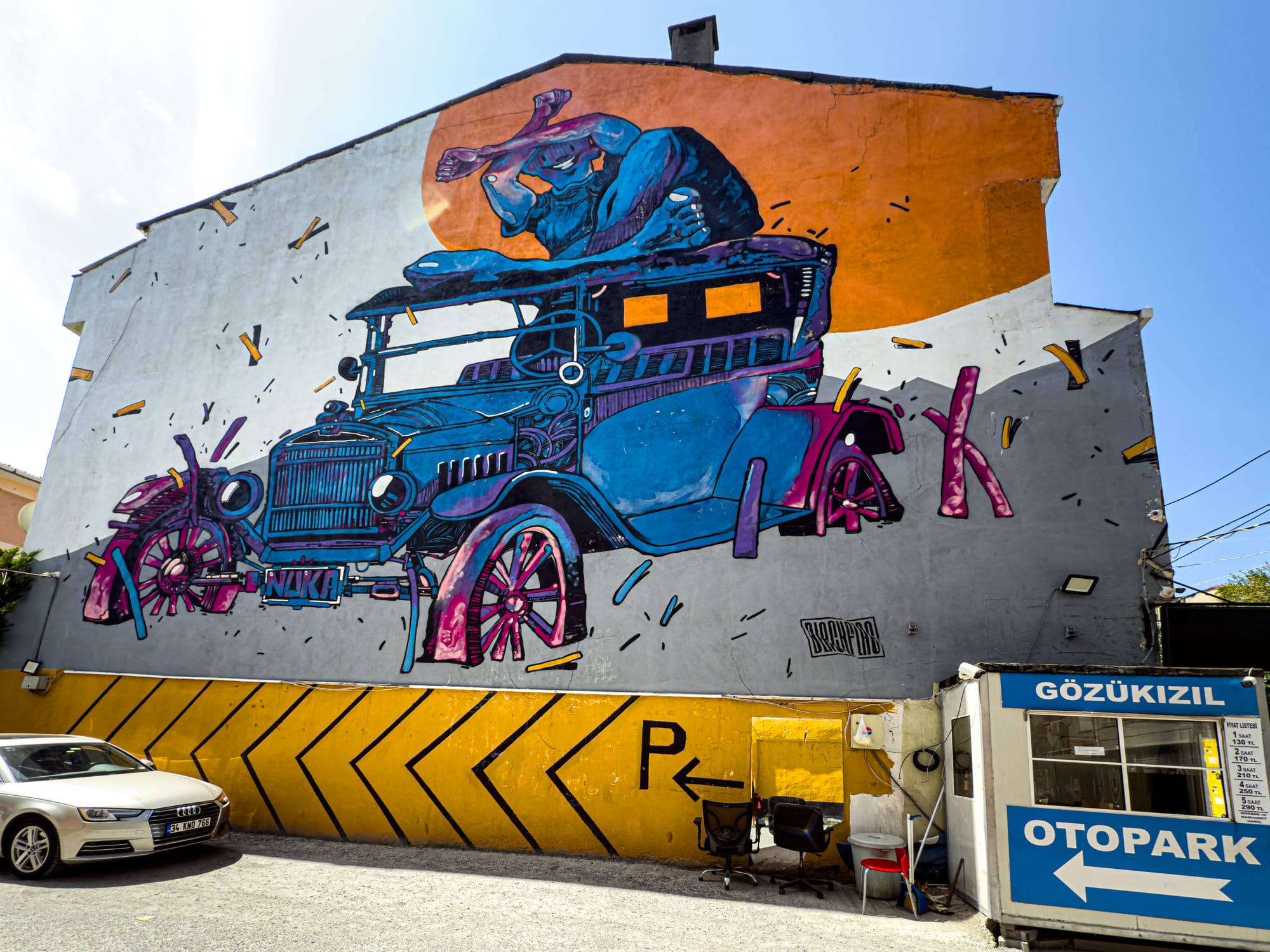
Two contrasting styles: a sleepy leopard tucked into a quiet corner, and a vivid cartoon car mural bursting with pop-art energy
Likewise, some of the murals we found online and really wanted to see were gone.
The political is present
While not every mural is overtly political, many touch on questions of identity, memory, and resistance. In a country where freedom of expression is often contested, the existence of these works—and their continued renewal—carries weight.
Kadıköy as cultural canvas
In many ways, Kadıköy is the ideal canvas. It’s a district defined by transit, by movement, by in-between-ness. Ferries arrive and depart. Generations shift. Murals come and go. And yet, the place holds an identity that’s unmistakable. This is what makes the street art here more than aesthetic. It’s collective memory. It’s neighborhood identity. It’s resistance and celebration, layered thickly on plaster and brick.
Looking to see some of these murals? Check out the maps that others have compiled at the links below. These are what we used to locate them.
If you'd like a guided street art tour by a local, this is the one we were eyeing.






